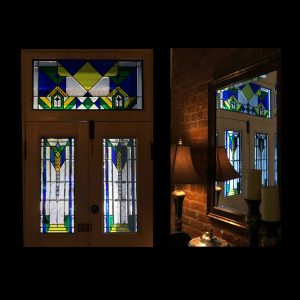
This is a collaboration with the owner of an 1880’s home in Churchill, Virginia that we installed yesterday. An excellent example of how our patrons expand our perception of our art.
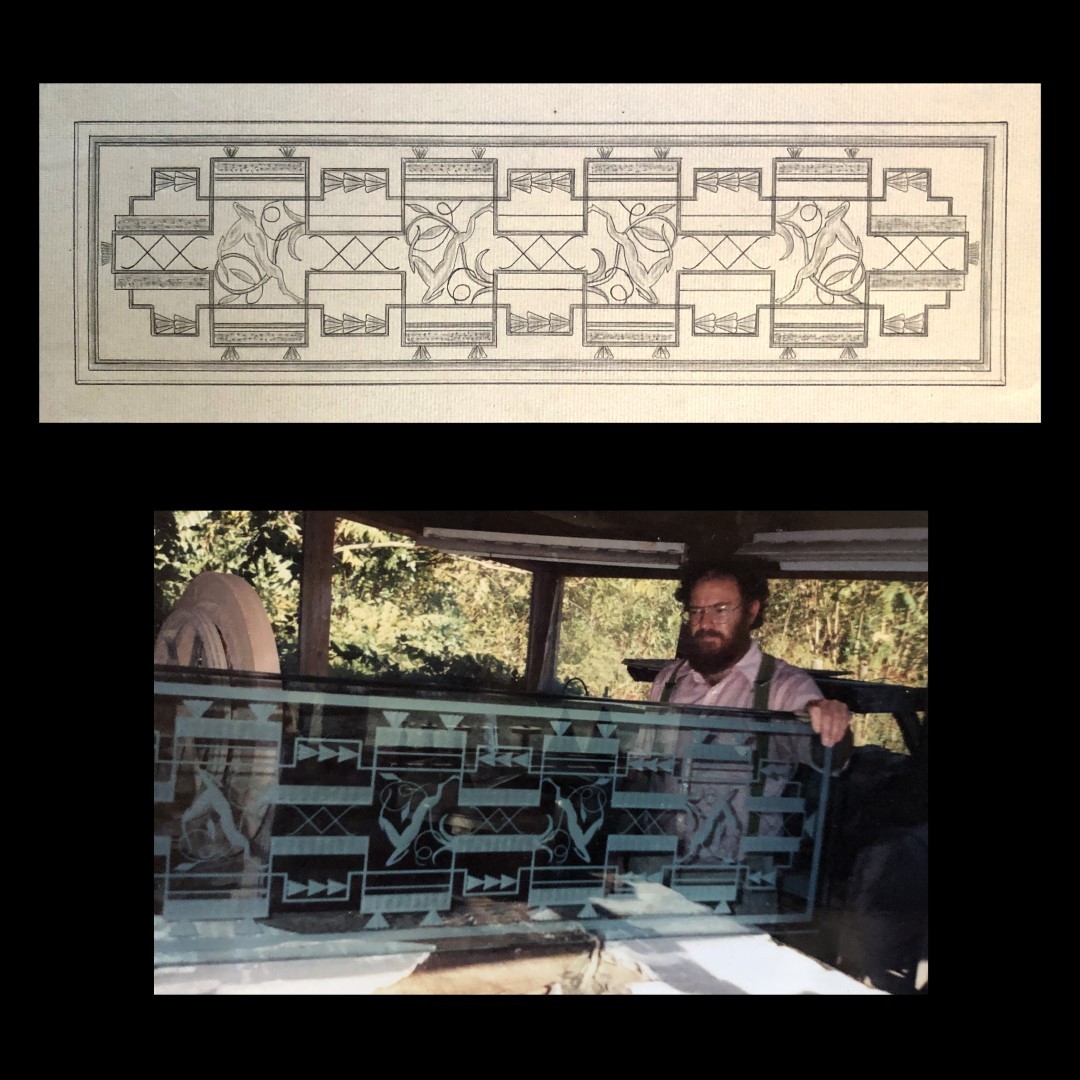
This is a tabletop I carved in 1987 and posted last Friday.
One can see how easy it would be to lose the whole project by simply over-carving or having the resist come loose.
There are two motivations when working on a project like this. One is to create a beautiful object, the other is fear of losing my independence.
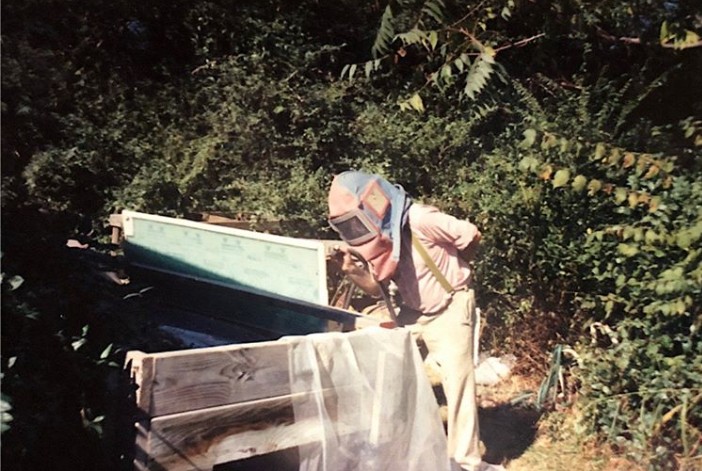
Carving glass is very tedious.
This was a 3/4″ thick tabletop that I carved an Art Deco design into. Getting into the right frame of mind, and maintaining it, in order to create such a large, intricate piece is a large part of the project that one rarely hears about.
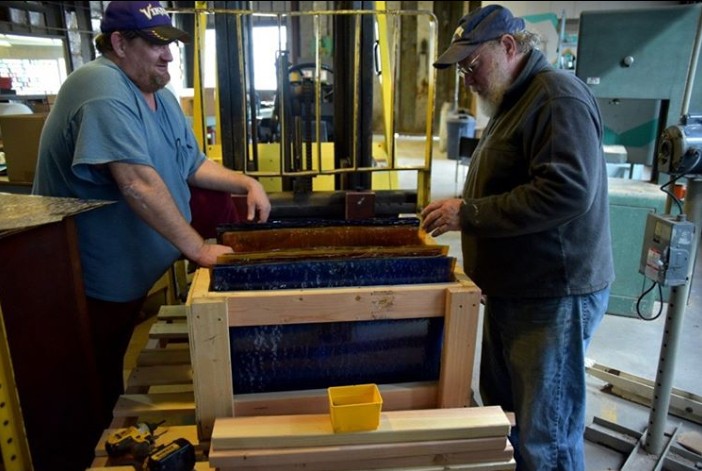
The relationships we develop along the way are a large part of the richness of our lives.
I wish I could remember this gentleman’s name, at the Blenko Glass Company in West Virginia, but I do remember his genuineness and kindness.
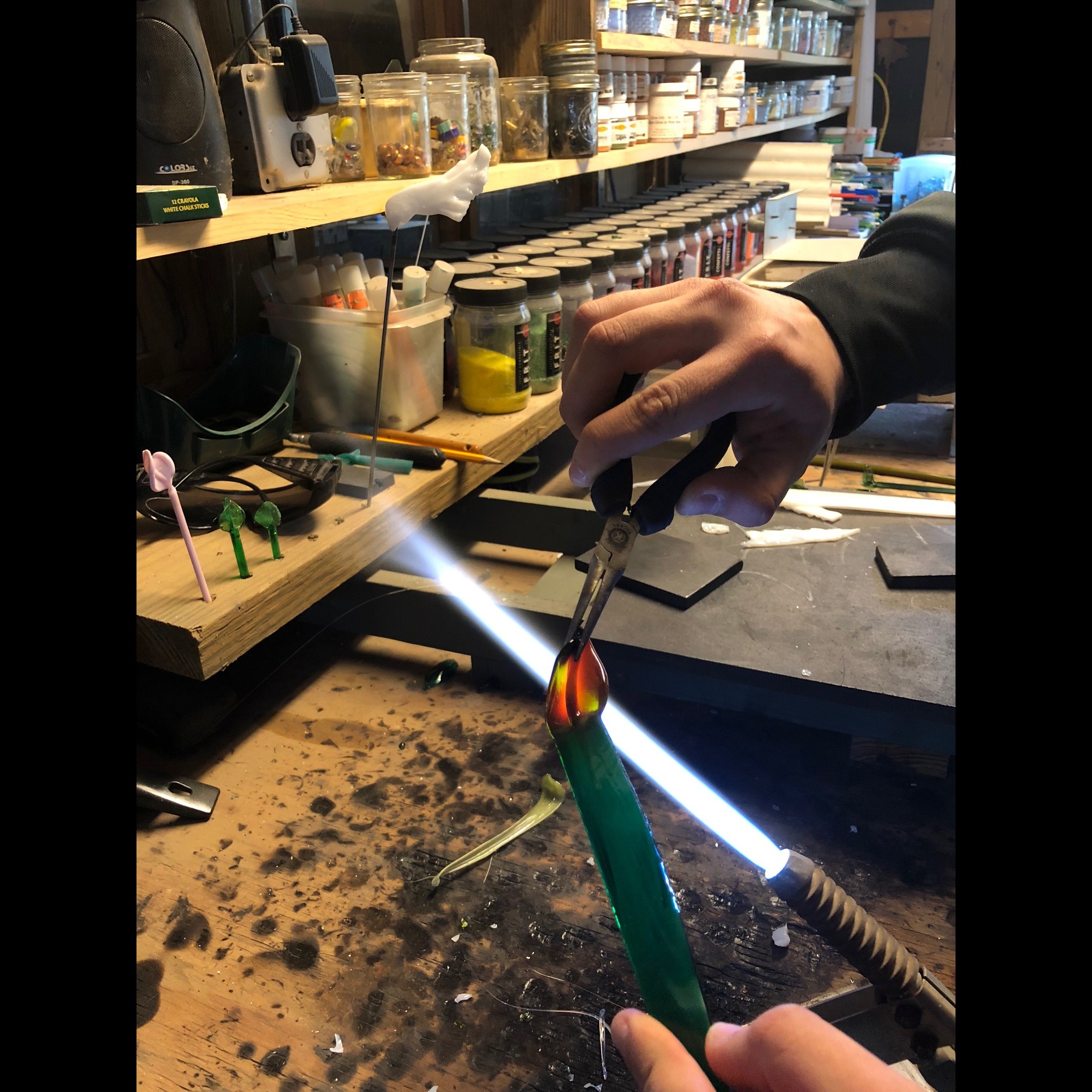
Turning a strip of glass into a 3-dimensional leaf took me years to perfect. I would often show guests baskets of hundreds of tries that I rejected before I was satisfied with something we could use.
I’m not sure what possesses me to go through this journey, but I am thankful to teach my fellow artist/craftsmen how to carry on and expand on this technique.

This is a fireplace screen we created around 40 years ago for a couple who had a room dedicated to art deco.
When we delivered it, all of us were so taken by the light and shadow casting from the carved and clear glass, that we ended up finding another place for it.
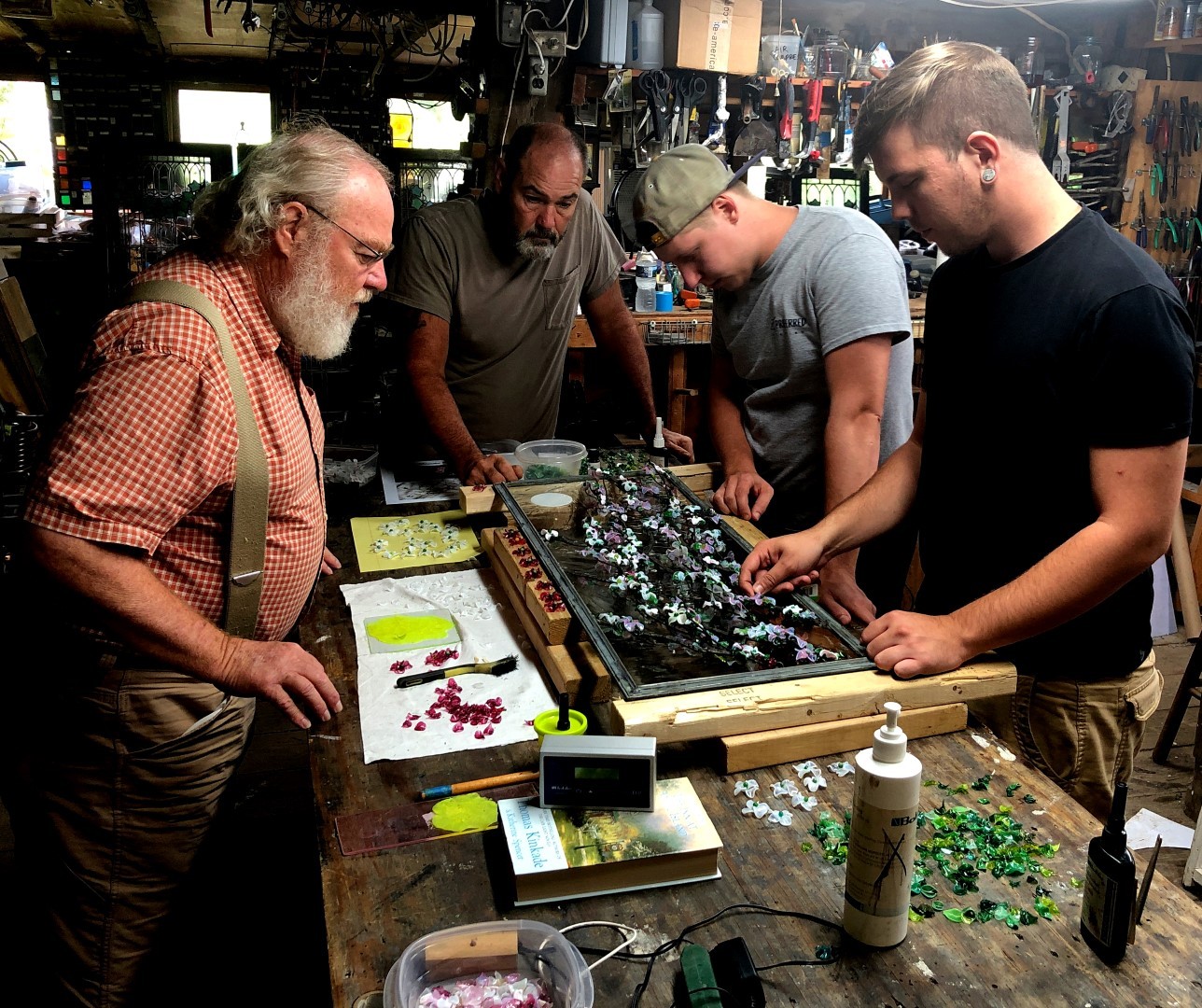
Nearing the completion of our window with the extended branches.
Critical decisions will be made today. Much discussion, one can just feel the excitement.
I wish I could say we break out into the Electric Slide to break the tension, but that’s not quite true.
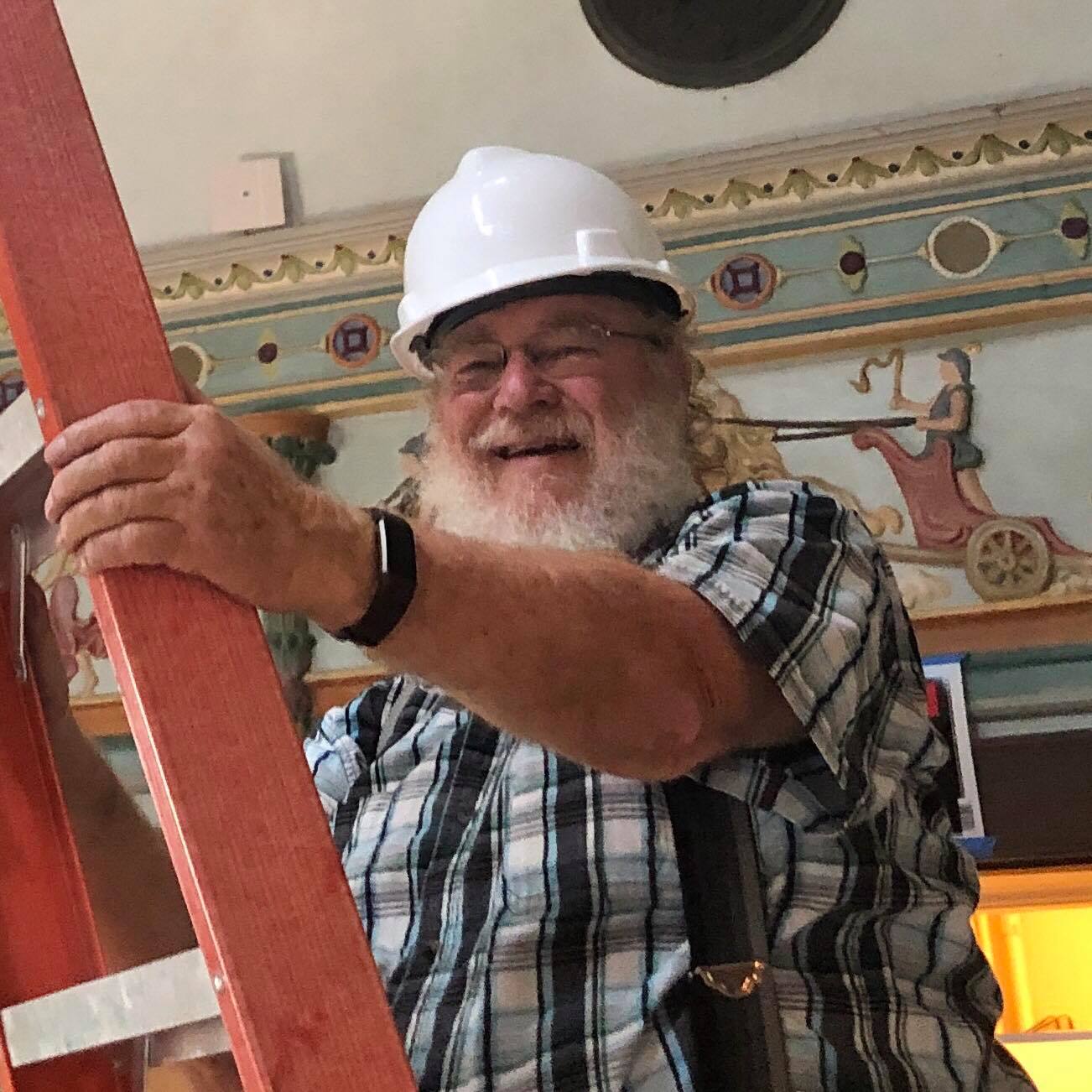
I feel fortunate to head up an organization that is so sensitive to the needs of the elderly.
I explained to my fellow artist/craftsmen last summer that we will probably keep on doing this up until the time I’m setting over in a corner looking like the late Stephen Hawkins did in his final years.
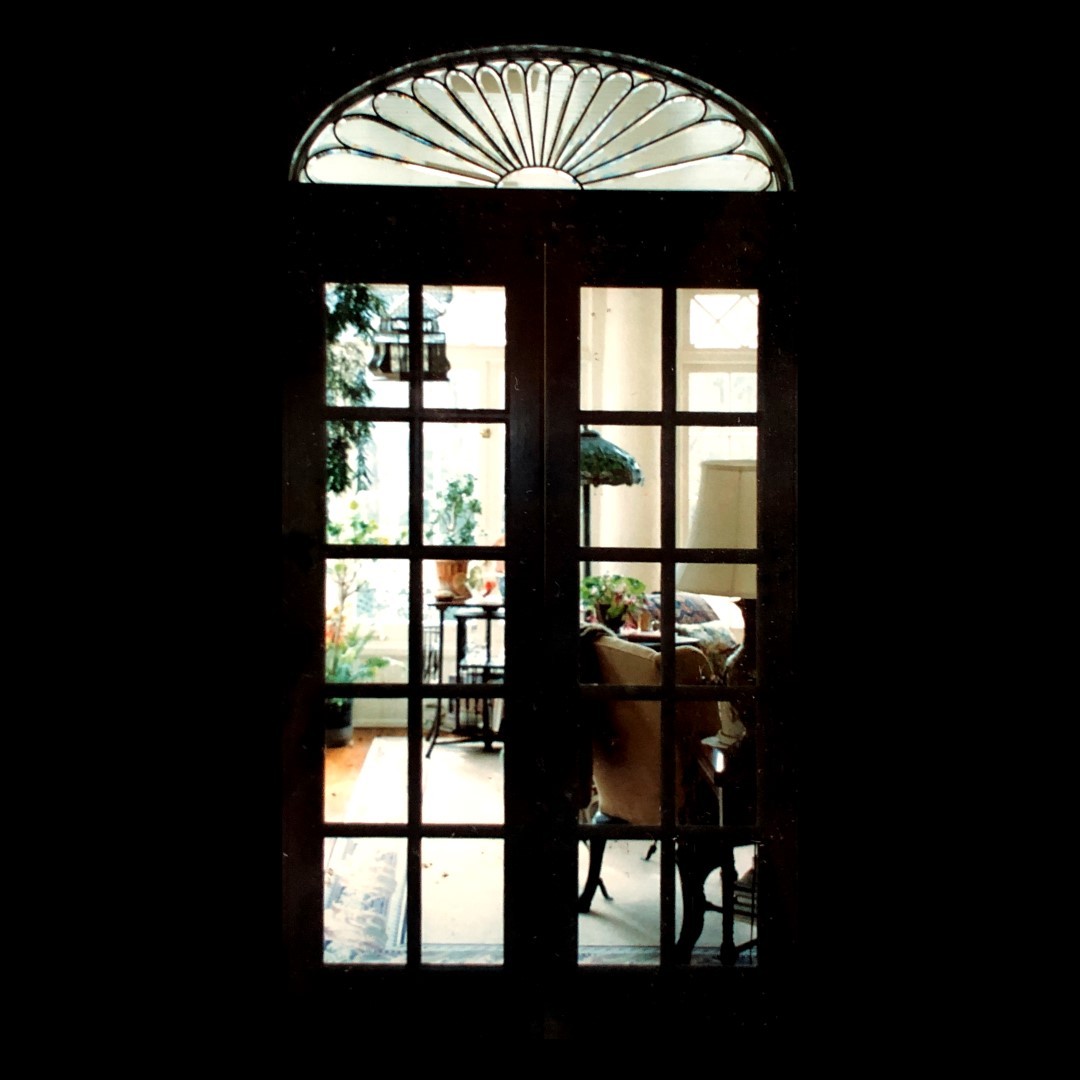
I have always enjoyed the challenge of embellishing a traditional design.
By slightly varying the widths of this fan transom, I believe it contributes to the inviting charm of this entryway into a well-appointed sun porch.
Richmond, Virginia, where I grew up and began my career as an artist/craftsman, was an excellent place to study the details of architecture. I am fortunate that my work has taken me into many of the historical homes where craftsmanship was highly regarded.

Today, once again, we are pushing the boundaries of our art. Just the beginning, but it lets us know that our idea will work and we can move forward.
This is a transom over a stairwell, with one side at normal height and the other side a 1/2 story lower. There is a skylight above the transom.
We thought it would be interesting to create wire “branches” to extend the leaves and petals beyond the surface of the window so the light from the skylight would filter down through our dogwood tree top.
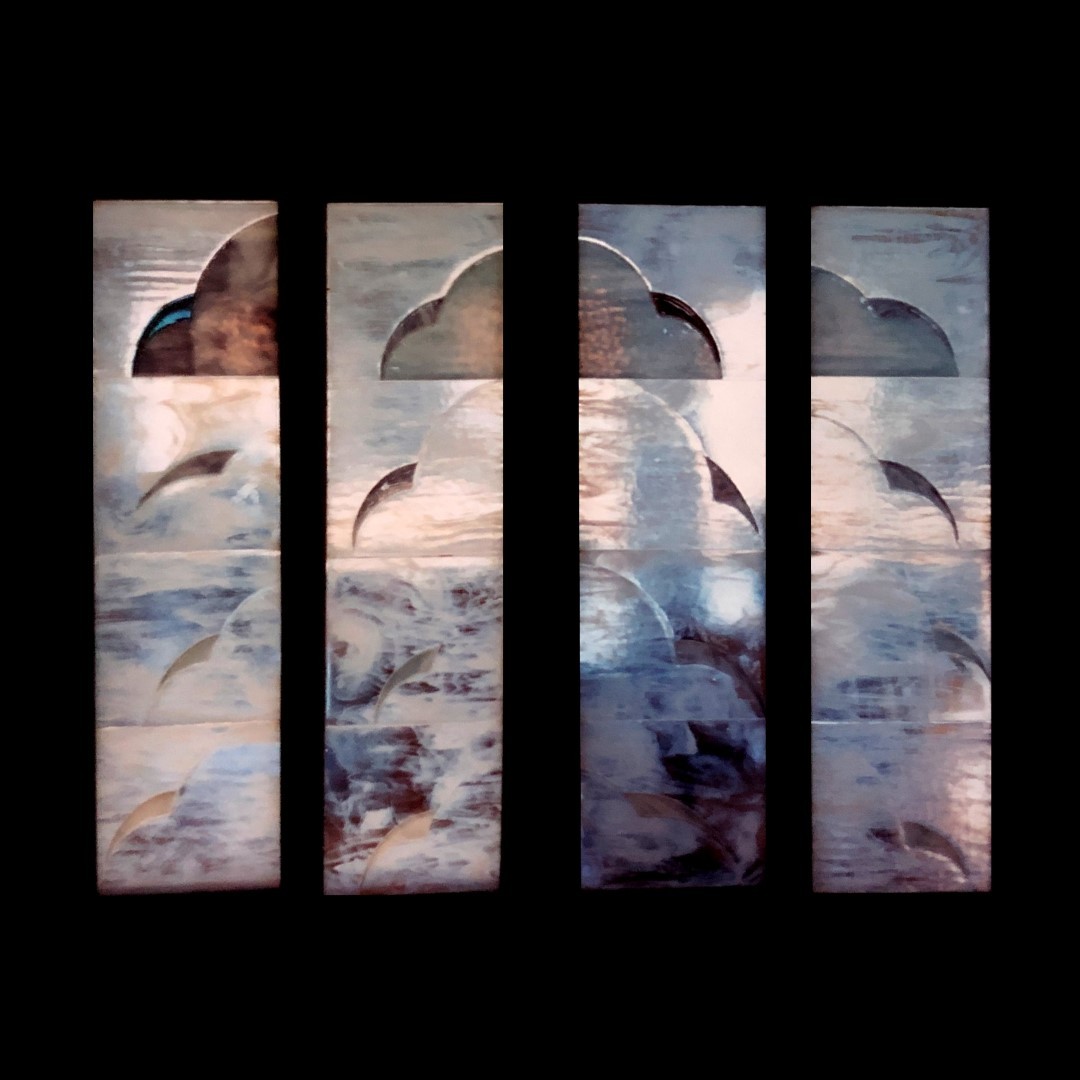
I created these two, double panel doors for a third-floor kitchen in a beachfront home in Duck, North Carolina.
Being high up, I thought it would be nice to have a feeling of being in the clouds while cooking and dining.
This was around 1985 when some of the glass factories began offering glass that made it possible to fuse different colors together. By cutting the glass slightly larger than the patterns, overlapping the edges and firing to the melting point, I was able to make these panels without lead lines. This allowed the sunlight to “hang” on the fused joints, moving from joint to joint as the day progressed. An unexpected and surprising discovery from this new process.


Glue chipping is a process where hot animal glue is poured onto the sandblasted surface of clear float glass. As it dries, the glue shrinks, removing flakes of glass from the surface.
This is one of six sheets we are currently making that has been chipped three times to achieve its beautiful character. In a few weeks, it will be cut to pattern, beveled and provide the background glass for the entryway in an 1880’s home in Richmond, Virginia.
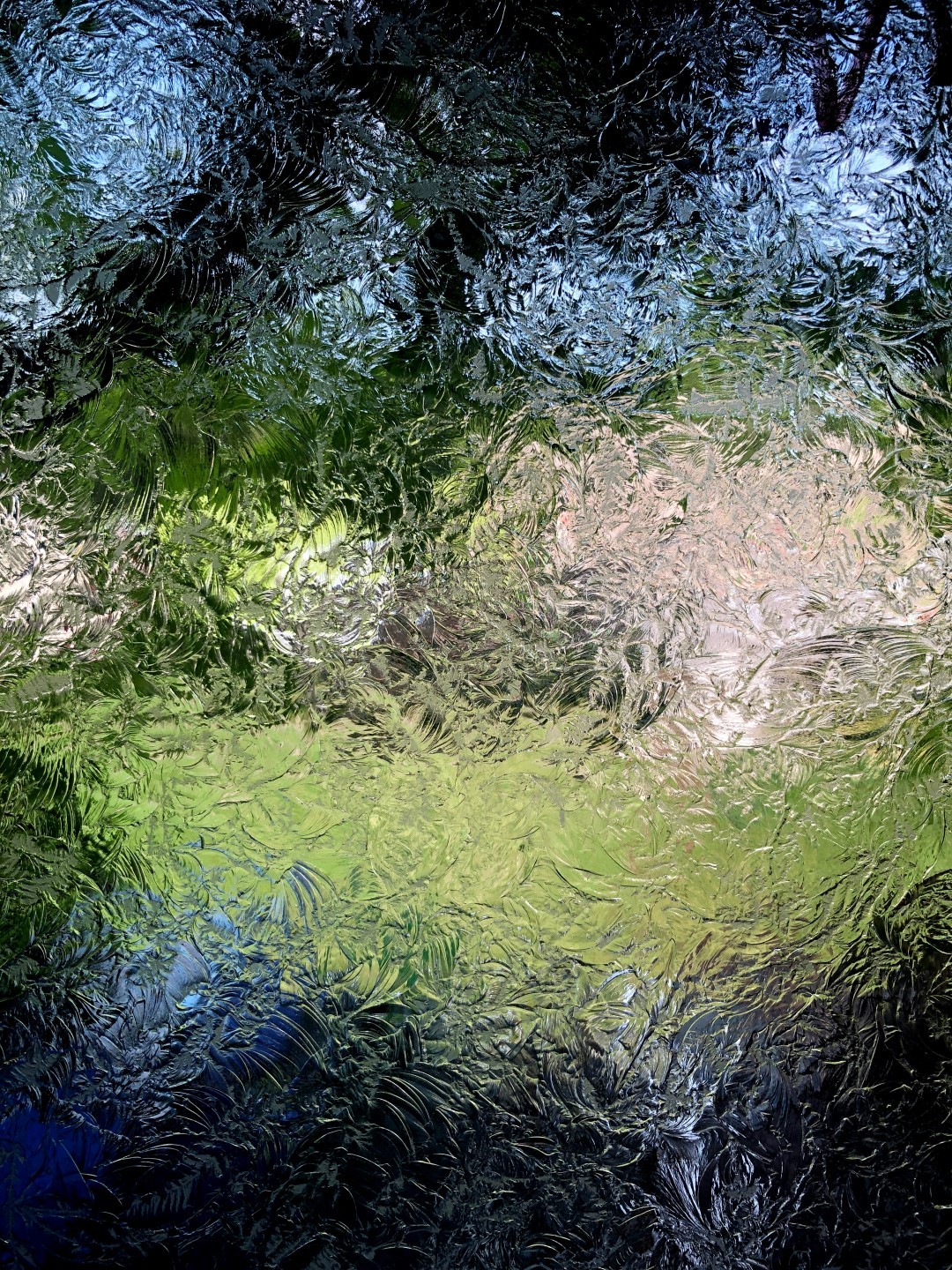
Glue chipping is a process where hot animal glue is poured onto the sandblasted surface of clear float glass. As it dries, the glue shrinks, removing flakes of glass from the surface.
This is one of six sheets we are currently making that has been chipped three times to achieve its beautiful character. In a few weeks, it will be cut to pattern, beveled and provide the background glass for the entryway in an 1880’s home in Richmond, Virginia.
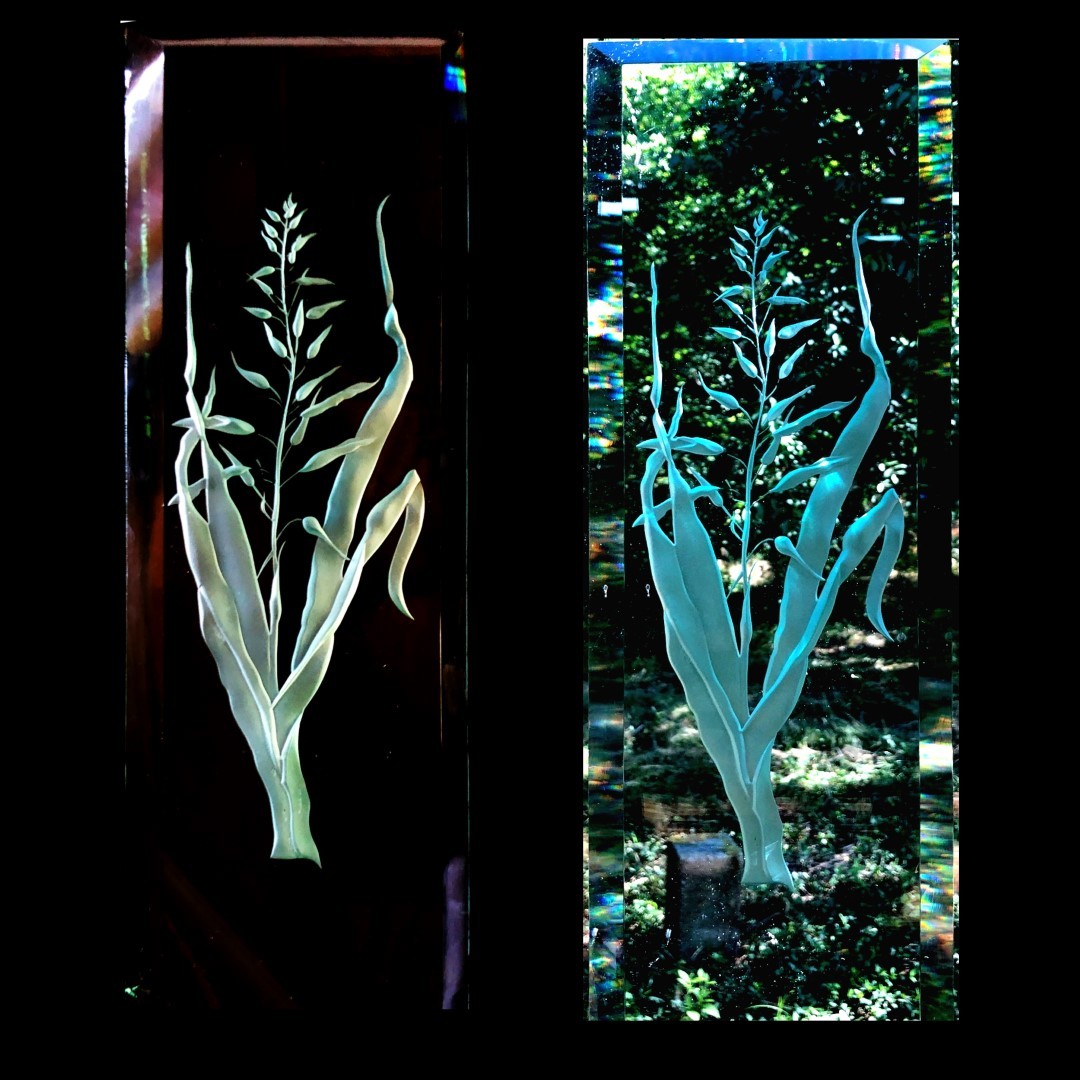
I appreciate how the vanishing line brings depth and perspective to a work of art.
I am especially fond of how it engages the imagination of the viewer, providing them with their own unique view of the object.
Carving in glass, with its delicate technique, is one of the best ways glass artist can express this concept. With the changing of light, the effect is even more striking.

This was a skylight from the stairwell of a three-story townhouse in Baltimore, Maryland. There is a general rule in color, that if one can not match it, choose another that works but is different. The idea is that it’s better to look like the choice was intentional and not a “missed hit.”
Fortunately, the centerpiece was missing which gave us the opportunity to practice this theory.

I created this design about 25 years ago for my own enjoyment.
My thought was to bevel various angles on 3 different thicknesses of clear glass for the accent pieces. Then surround them with the beautiful striations and bubbles of blown glass.
I also find it interesting, the symbolism one can read into one’s work when drawing in a “free association” state of mind.
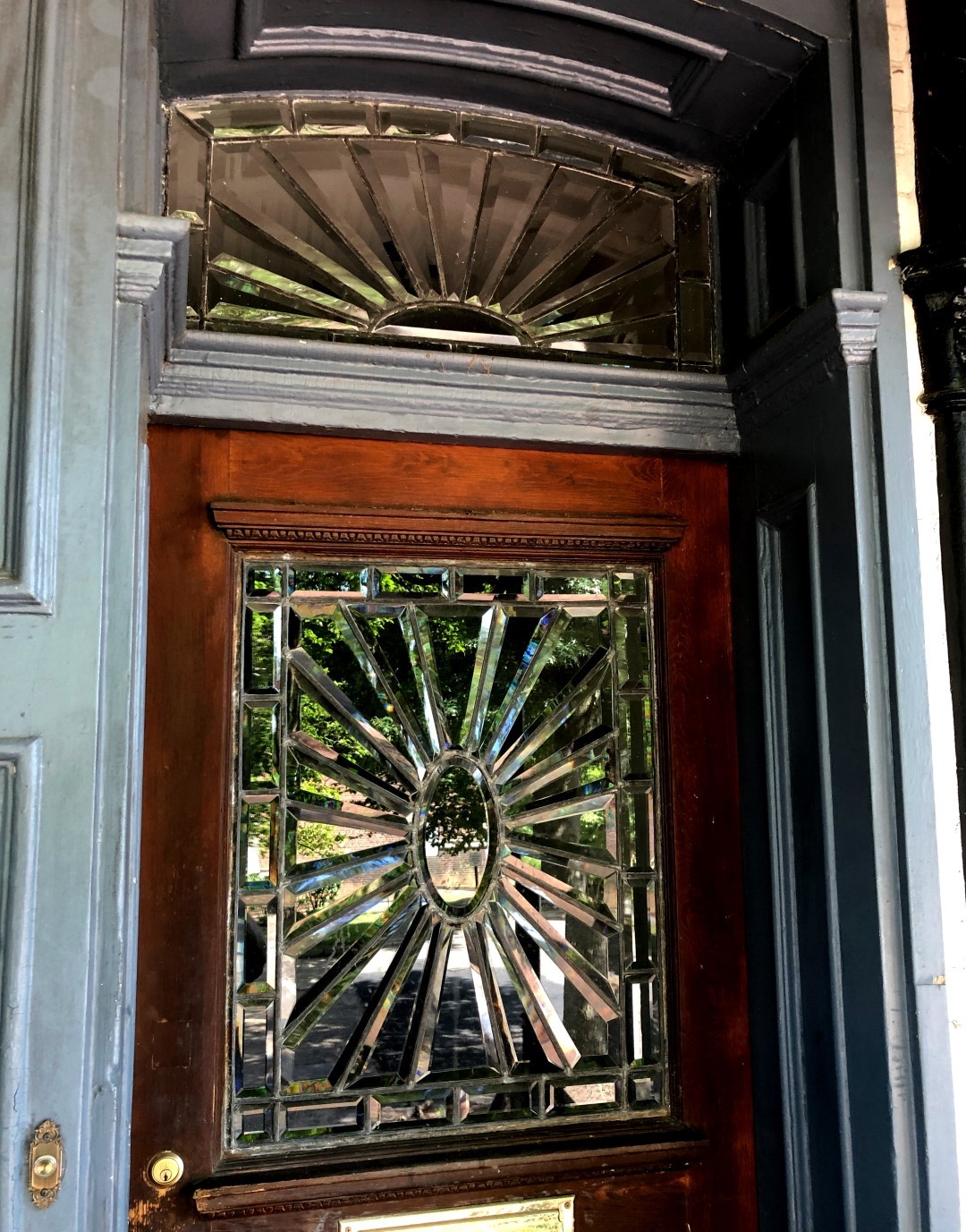
Traveling through the Church Hill section of Richmond Virginia last week, I came across a beveled glass window I created for an entryway around 1982.
If you look close, you will notice the variable bevels, wider at the larger end and tapering to the narrow. In order to create this effect, I needed to work with 3/8″ glass. It takes considerable skill to cut glass that thick and bevel it so it fits into a relatively narrow zinc came.
It was quite gratifying to see how beautifully my work fits into this historical neighborhood 37 years later.
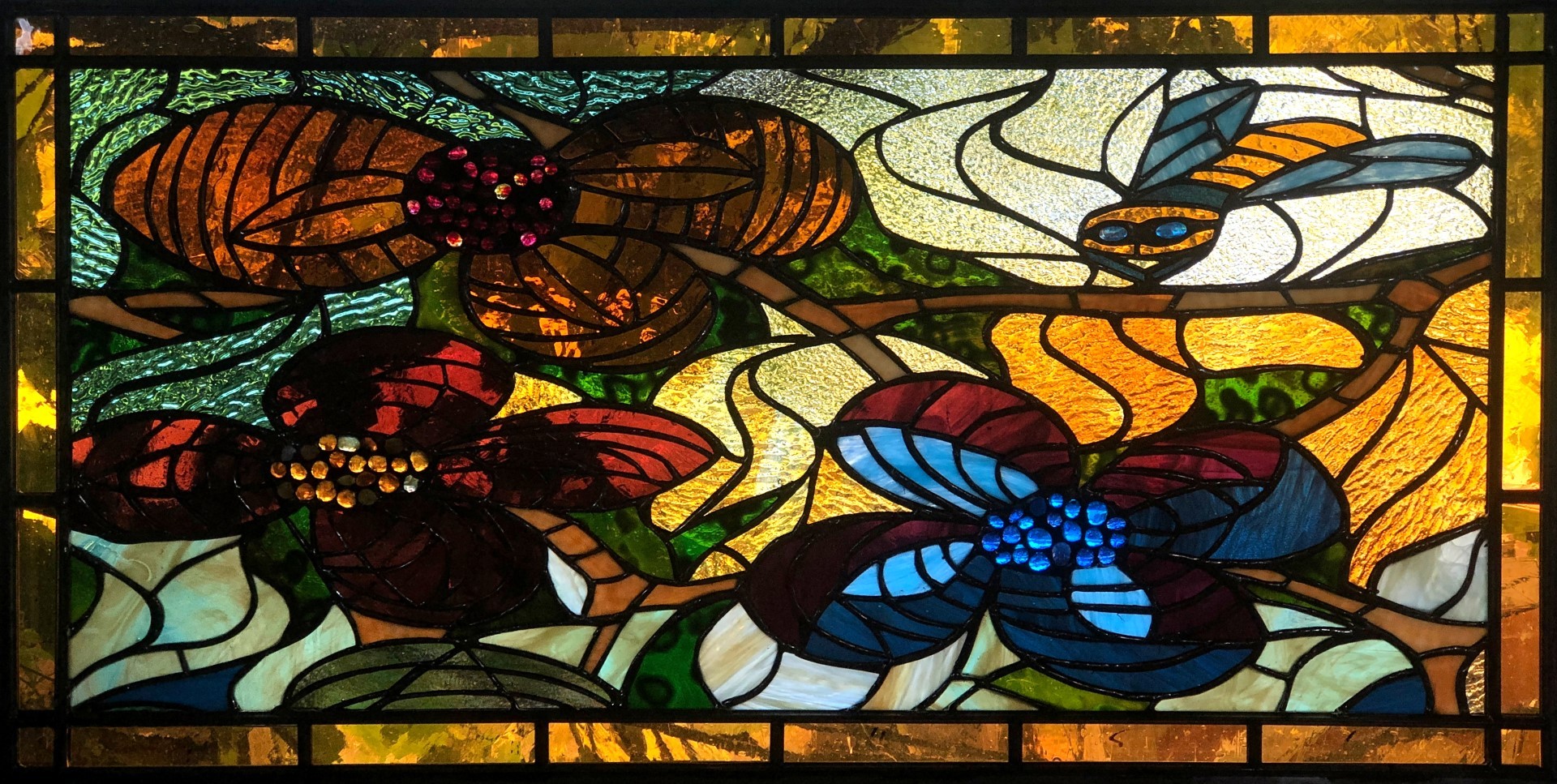
It’s not often a client comes to our studio with an album cover in hand, requesting that we use the background from the Beach Boys, Wild Honey album as inspiration in creating a transom window for his listening room.
For us, it was a wonderful opportunity to be playful with color, our flameworking, and the push-pull effect of opaque and translucent glass in the same window.
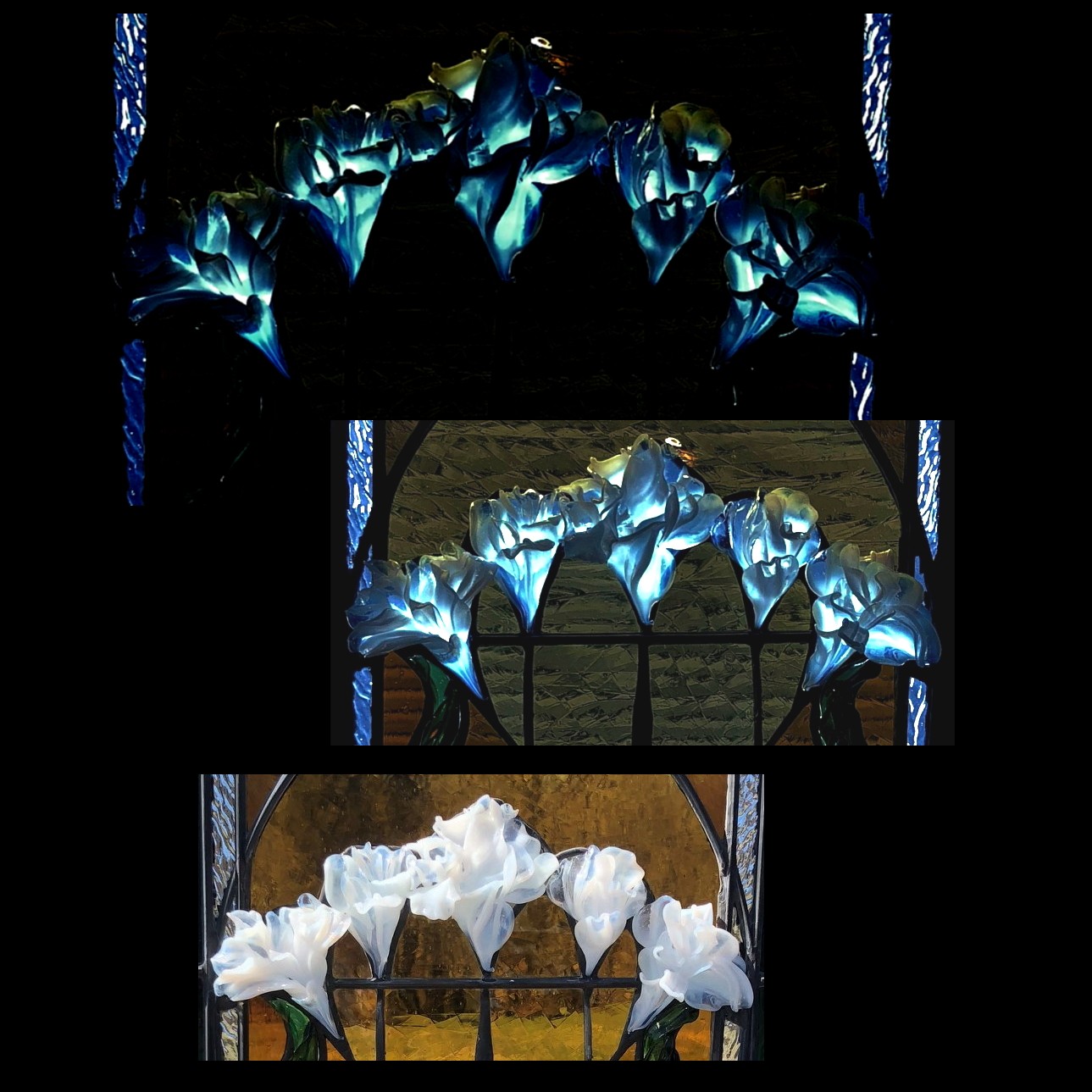
Here is a beautiful example of what some of us glass artists call, “the moodiness of glass.” This particular effect was enhanced by the inner-city street lights.
Ever since we started flameworking 6 years ago, in our pursuit of recreating the translucency of nature in glass, we have had many surprises. This window was a giant step in the evolution of our work.
This white lily window is one of our favorite. It is now in the home of two professors in Germantown, Ohio.
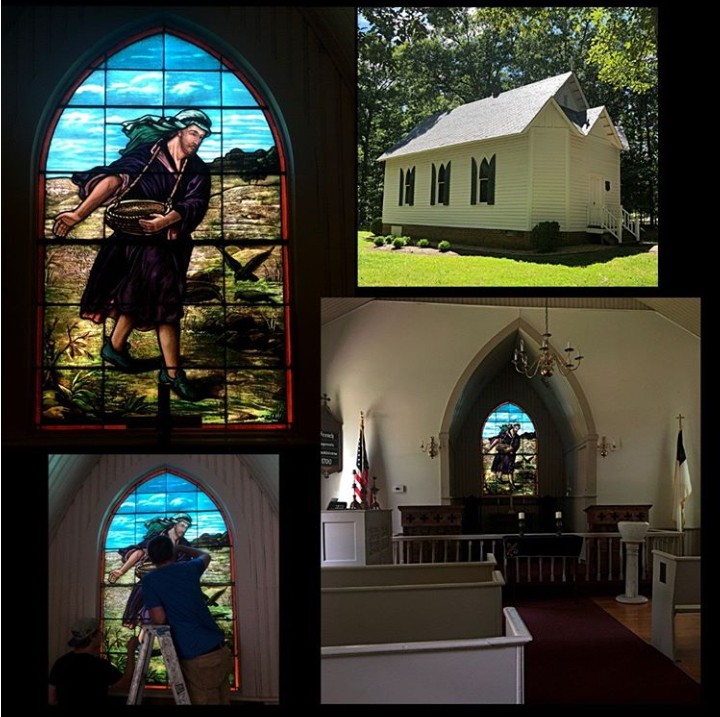
Last Friday, we spent the day performing light restoration on the stained glass window at the Manakin Church, just west of Richmond, Virginia. The church was built in 1895 for $129.00, using mostly materials from the previous church that burned.
The only stained glass window, the “Parable of the Sower” depicts the sower scattering seed, a symbol of the Word of God. Some seed has fallen along the wayside and is being devoured by birds, while another seed has fallen on stony ground where it will die. The seed that fell on fertile soil will flourish, symbolizing the virtuous life.
When I first started my career in stained glass, it was very difficult obtaining commissions. I ended up performing a lot of restoration work, mostly on churches in impoverished areas that were heavily damaged.
It was hard, dusty work but a wonderful learning experience.
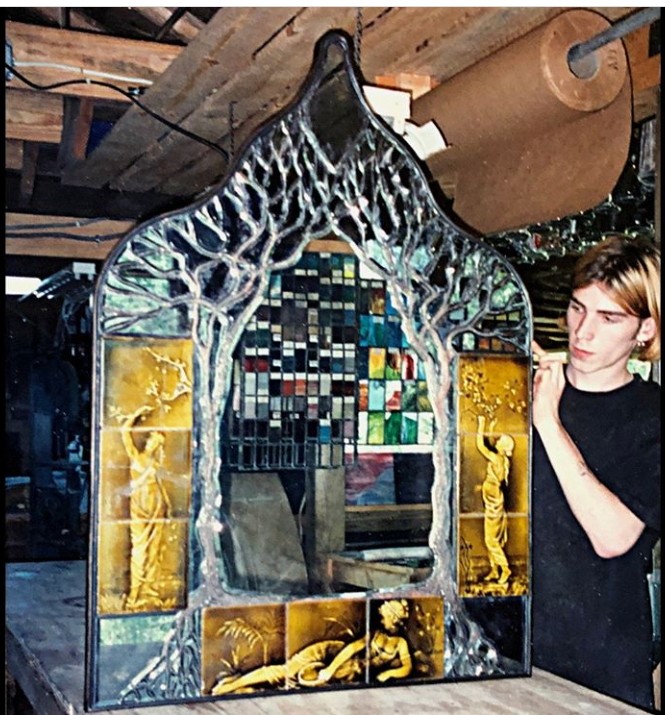
This is a mirror I created around 25 years ago.
The only request my client had was to use some tiles that she was quite fond of.
After designing and beveling the glass, I silvered the outer pieces darker by contaminating the silver solution. Then silvered the large centerpiece lighter so it would draw the user into the mirror.
Sculpturing the solder to hold everything together and applying a patina completed the piece. I am especially fond of the way the roots are squeezing through the tiles.
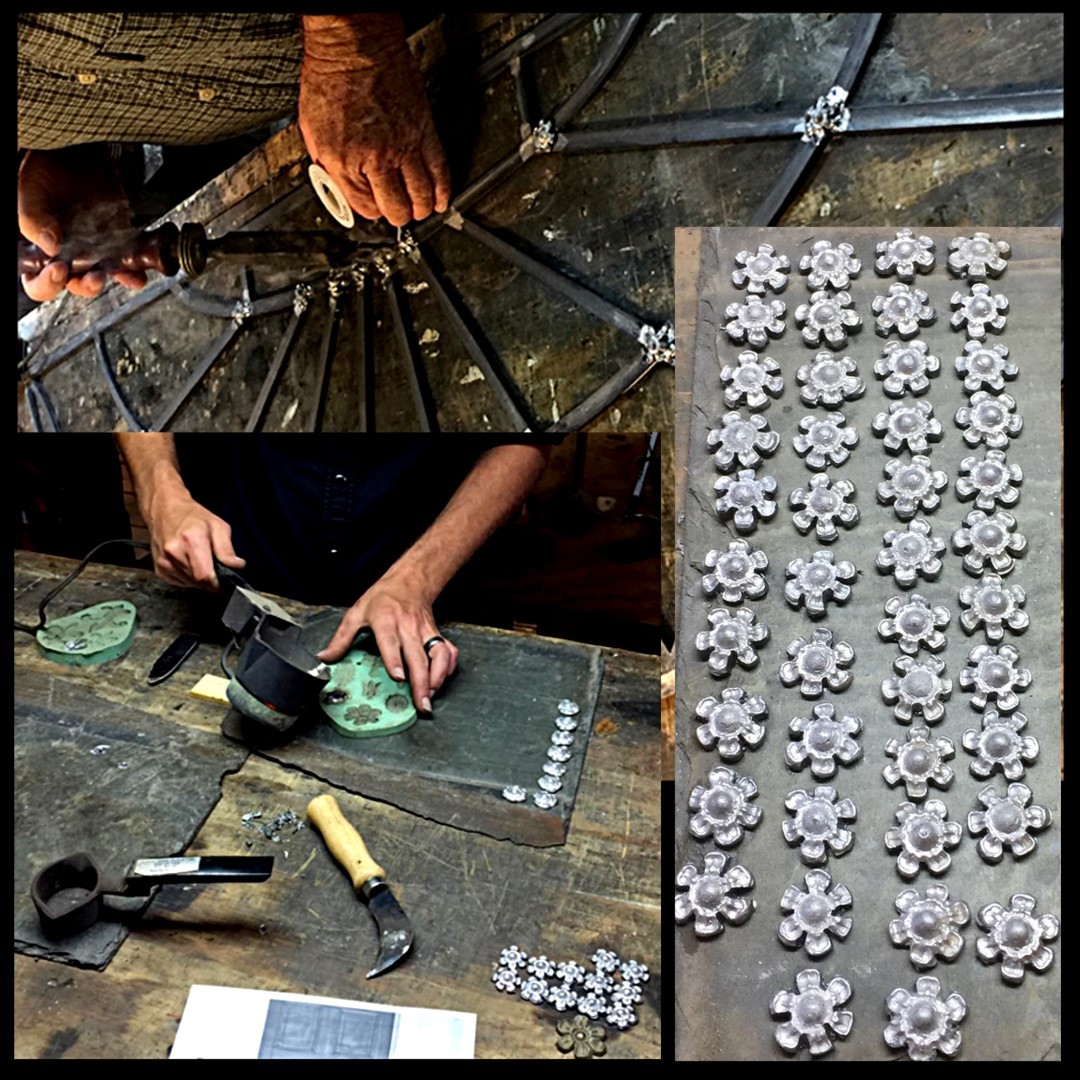
Over the years we have restored quite a few leaded glass entryways. Many of them had little rosettes used to embellish the joints between simple lead lines.
Whenever we found a rosette, we would always make a mold so the design could be reproduced.

One of our current projects is recreating the design for The Beach Boys album, “Wild Honey” cover with stained glass.
Our first goal was to create a jewel-like effect for the centers of the flowers. By experimenting with many different colors of glass and how they reacted to flameworking, we were able to find ones that would reconfigure themselves into the jewel-like quality we were seeking.
Now that we have our focal points, we will begin creating the rest of the window around them.






We installed a window we’ve been working on for the last 6 months, a restoration project of a 100-year-old window.
The challenge in these projects is finding matching glass. We visited The Paul Wissmach Glass Company (1904) in West Virginia and found some of the border colors. For the background, we worked with Kokomo Opalescent Glass Co. (1888) in Kokomo, Indiana, who found matching glass in their storage.
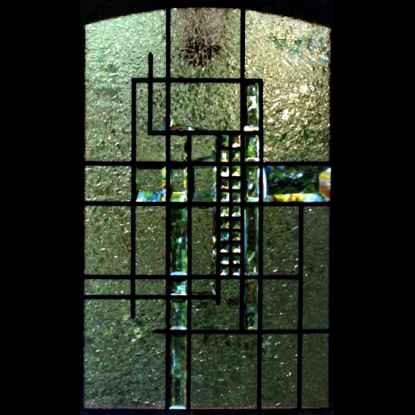
I created this window for an elevator door in a home around 30 years ago. I believe it is the first time I started using extended lines in my work.
Traditionally, the lines in art glass stop when they connect to another line. I believe the extensions developed in my design process of drawing lines on paper, erasing, redrawing and finally realizing in seeing the new lines overlaying the shadows of erased lines, the possibility of a new design element.

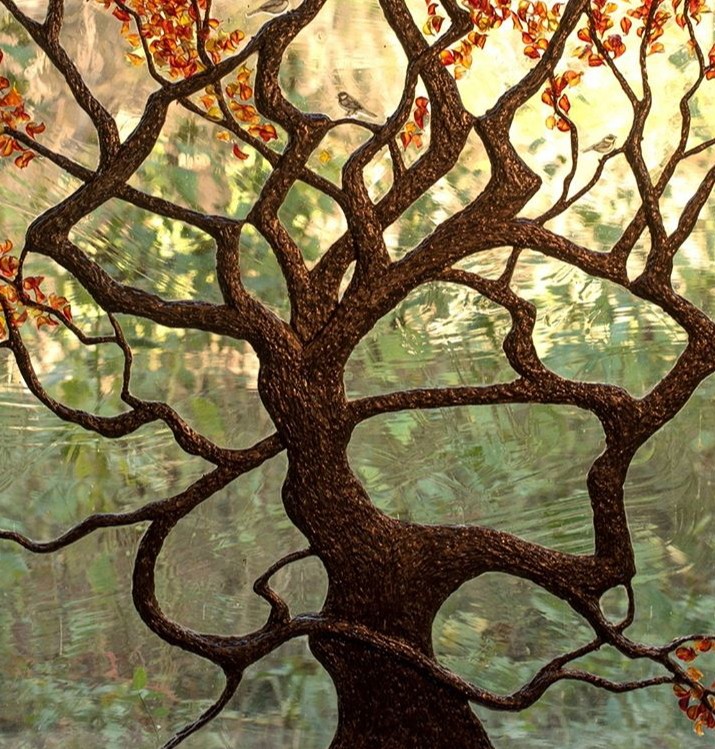
Introducing sculpture into our work around 25 years ago opened up so many new design possibilities.
Traditionally, we were limited to designing with lead cames of consistent widths.
I have no idea how long I spent sketching this idea, trying to build character. Nor, how long it took Daniel to bring it to life.

In February 2013, we completed 2 rose windows for the Priory at St. Thomas Aquinas Church in Charlottesville.
This is one of the sections that shows the highly developed painting skills of artist, Daniel White.
The surrounding glass framing the painted piece was carefully chosen to compliment the painting, while at the same time not distracting from it.
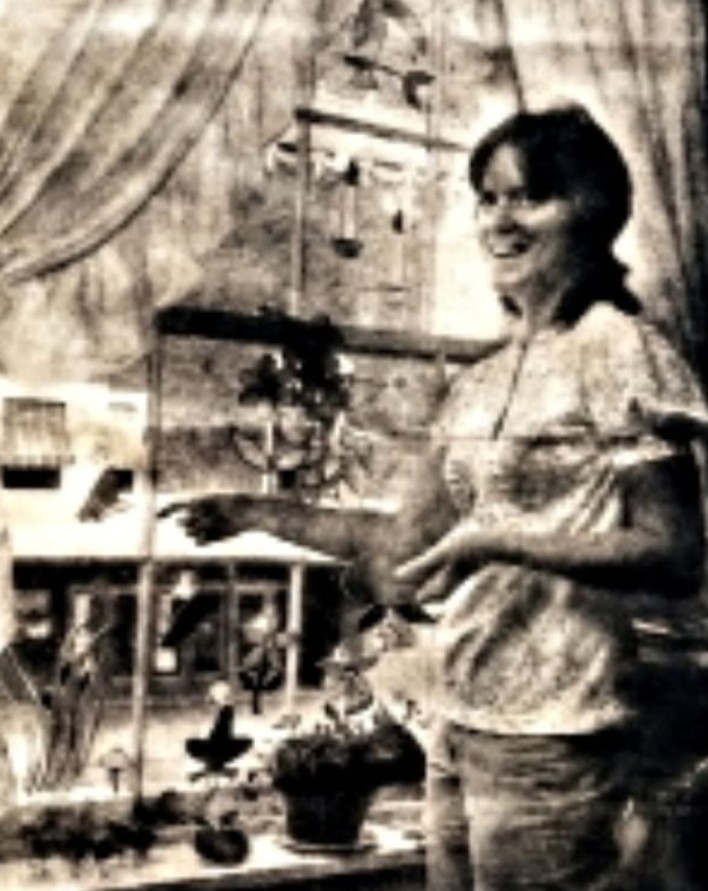
Next month, I will celebrate the beginning of my 48th year of working in art glass.
Fresh out of college with a degree in sociology, I knew that I wanted to be self-employed, have my own product, and be compensated in relation to the effort I put into my career. My philosophy was that one should work and make the money needed to live the life one desires, balanced with the freedom to enjoy life’s other pleasures. I also knew I would never be happy in a structured work environment, following someone else’s direction.
In June of 1972, I drove my 1962 VW bus to Whittemore-Durgin Stained Glass Supplies, in Rockland, Massachusetts to purchase some sheets of stained glass, foil, lead came and solder to begin my journey. I remember sleeping in my bus to save every penny I could to buy my first supplies. Those of you who know me, know I’m a rather “thrifty” fellow.
Literally starting on the kitchen table, I made hanging apples, pears, cherries and chickens that stood on one leg, selling them at craft fairs and gift shops by the dozens. I was one happy fellow, finally free of what everyone else wanted me to do and heading down my own self-directed path.
This is Sue, my first wife, showing off my creations. The most tolerant and supportive woman a fellow could ever hope for.
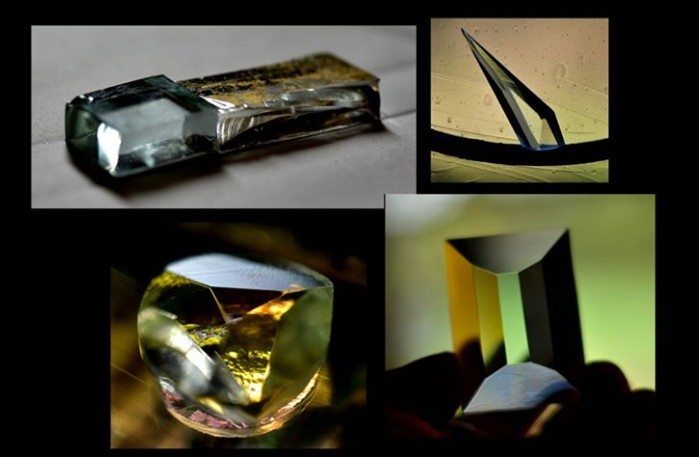
Some of the magic we’ve discovered over the years, working glass over our 1915 beveling machinery.
Cutting 3/8″ and 1/2″ glass to a pattern, and free-handing them over large steel, stone, cork, and felt wheels that are rotating around 200 RPM, one is able to create various angles that bring character to the overall project.
We achieve the gold by using an old mirror we found that still had some of the tarnished silver. By carefully cutting and going through the beveling processes, we were able to preserve enough to give the pieces a special antique sparkle. Under the round bevel, we placed a piece of iridized glass to reflect light.
Over the years, we have discovered many little techniques such as this through our constant “thinking and doing, doing and thinking.” Thank you, Goethe.
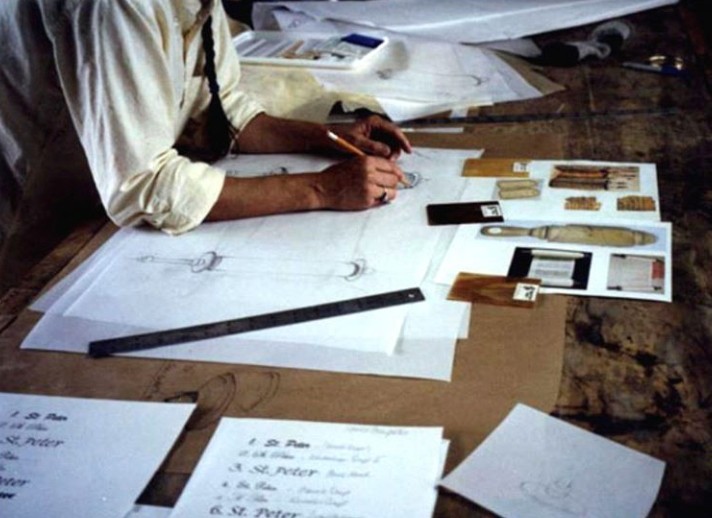
A lot of thought goes into the preparation of our art.
Communication with our client, often visiting the site, designing and design approval, creating patterns, color selection, and pulling together the materials are all necessary for a successful project.
We estimate that we are halfway through a project before we even cut the first piece of glass.
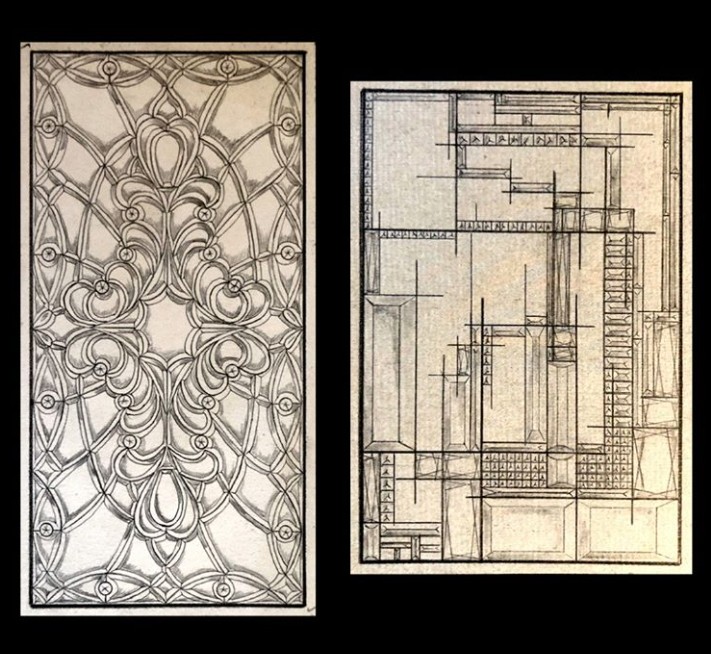
These two drawings show the evolution of my traditional beveling designs to my contemporary style over the last 40 years.
When one views symmetrical windows, the mind remembers the design quickly and it soon becomes another object in the room. By beveling various angles and thicknesses of glass, blown glass from Germany in the background, in an asymmetrical arrangement, I was able to create windows that would challenge one’s mind by breaking the spell of consistency.

A couple of sidelights we beveled on our 1915 machinery. By holding the glass over rotating iron, stone, cork, and felt, one achieves many small facets that give our bevel glass windows their sparkle.
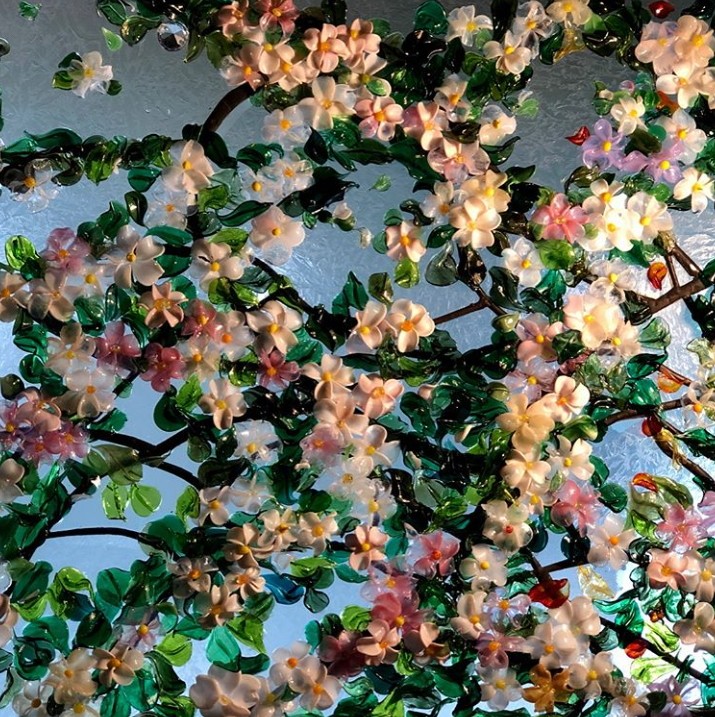
Close-up photographs of our recently completed The Four Seasons of The Kew Rose
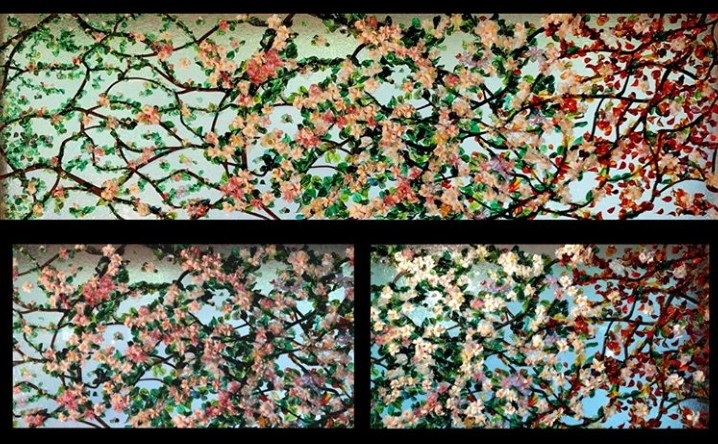
We were commissioned to express the 4 different seasons of the kew rose in two different transom windows.

I created this lamp in 1982 for a couple in Richmond, Virginia. We picked up the carving design from an oriental rug that was below it, beveled the glass on our 1915 machinery, and assembled with zinc came.

This is a drawing I did around 30 years ago. I was getting bored with doing traditional bevel glass designs and wanted to expand my ideas into a more creative and contemporary style.
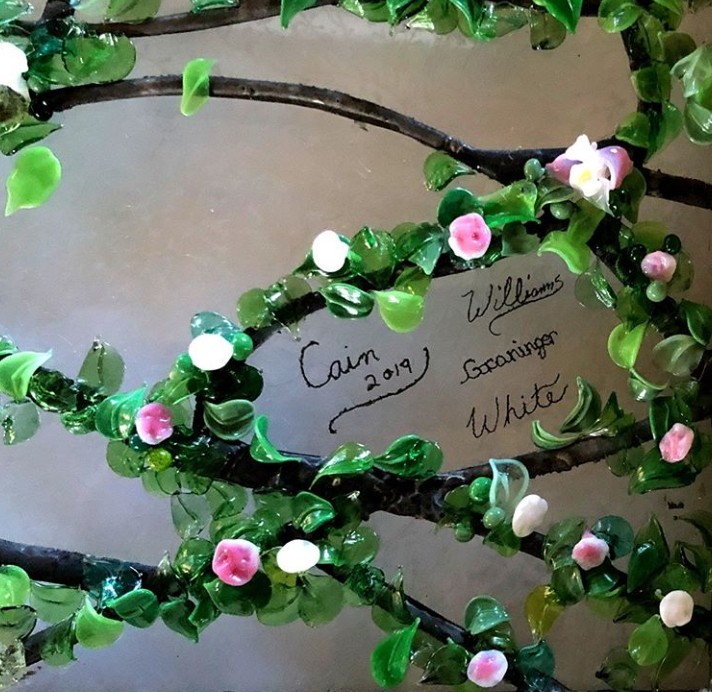
One of the reasons I enjoy my work so much is that I like the people I work with. It gives me great pleasure to see their signatures alongside mine.
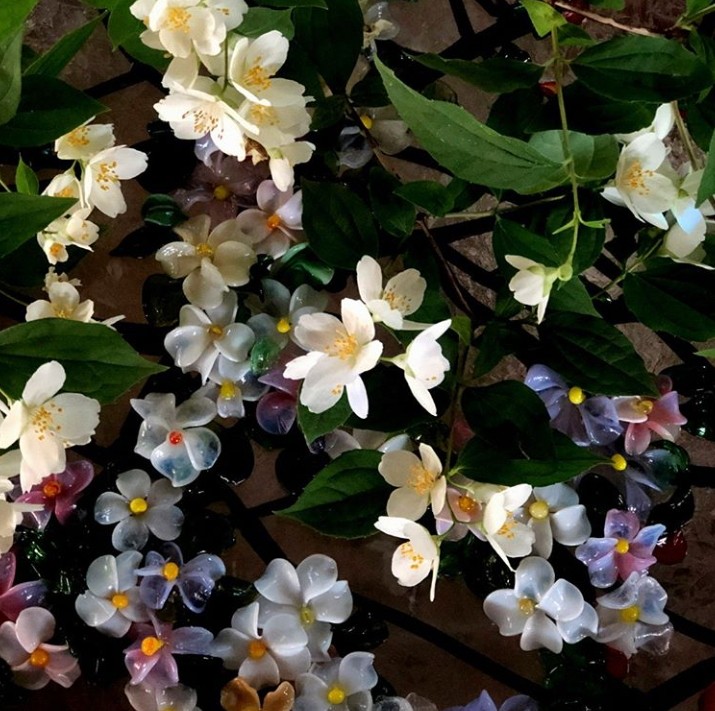
Here we overlaid the branch of a kew rose onto our glass interpretation for one of our current stained glass window projects.
Please visit our Instagram and website to see the many projects we’ve created over the past 46 years.
www.waynecain.com

In our studio, we strive to maintain a very upbeat attitude towards our work. It is important that we share ideas in a positive way. Negativity dulls our senses and stifles our creativity.
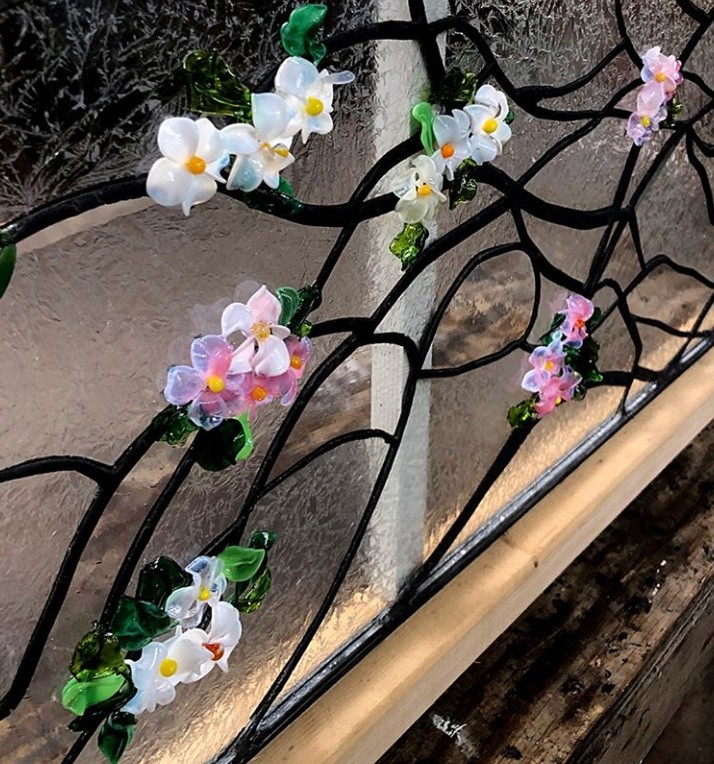
The beginning of our current project, the 4 seasons of the kew rose.

Around 1990, I started experimenting with beveling 1/4″ colored glass on our 1915 machinery. In some openings, it created a very subtle jewel-like quality for the architecture.
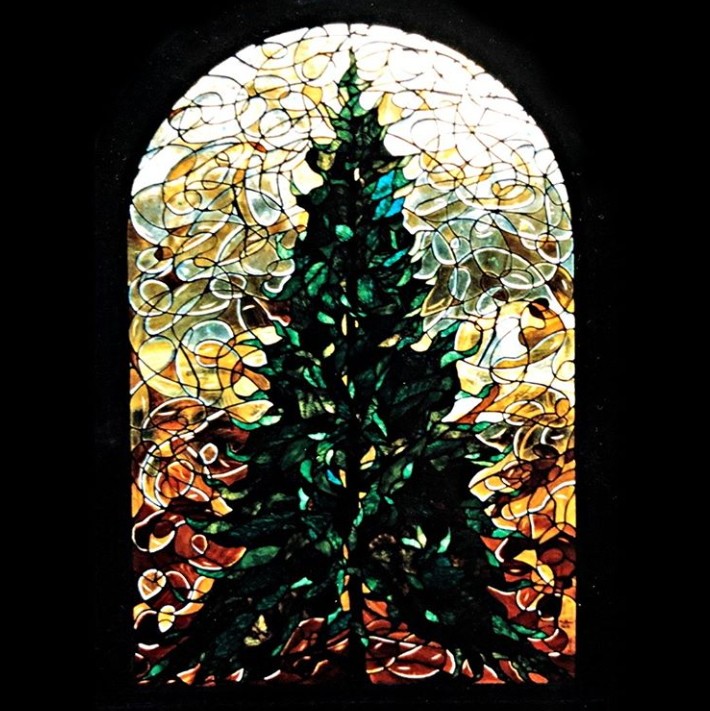
During the summer of 2003, our 5 children and I created this window for their school, Tandem Friends School, Charlottesville, VA.
We wanted to express the energy and excitement this wonderful environment provided for it’s students.
Over the years they have often commented on the value and influence they received while there.
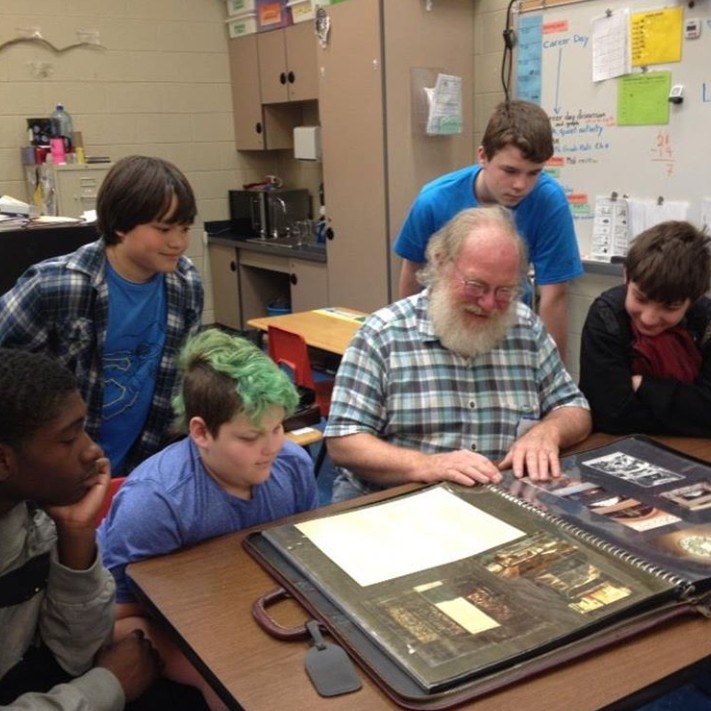
Me, showing off at Career Day.
April 2013.
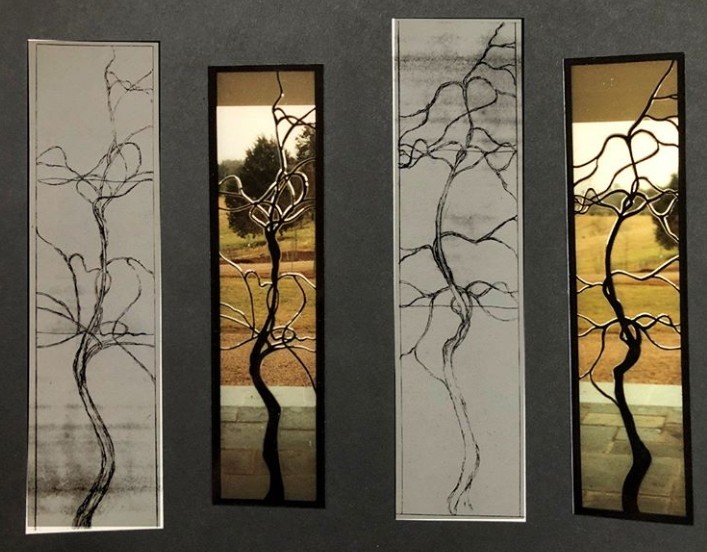
A couple of sidelights I created, around 20 years ago, for a couple who owns a vineyard in Whitehall, VA.
I wanted to create the illusion of ice on the early morning vine. To achieve this, I beveled short, steep bevels around some of the design.
By sculpturing the vine with solder, I was able to compete a realistic winter scene.
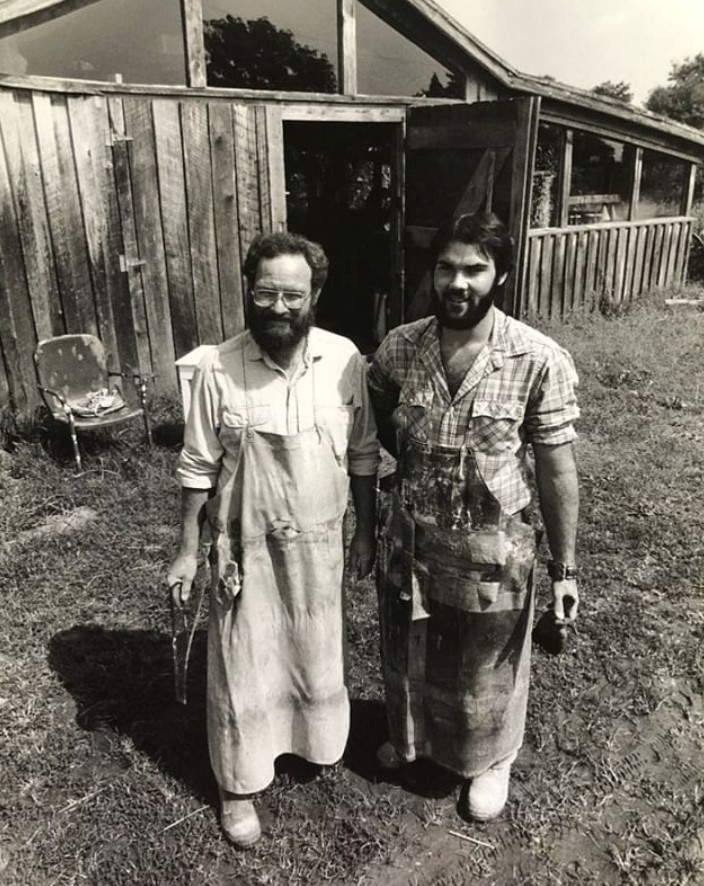
When I moved from Richmond to Bremo Bluff, 36 years ago, my first helper was John Williams, who was 17 at the time.
I suppose by the duct tape on our aprons and the smiles on our faces, you can tell we were two happy fellows.
John had many other occupations over the years, as well as serving in the navy. He is now back working with us with a new apron and a bigger smile.
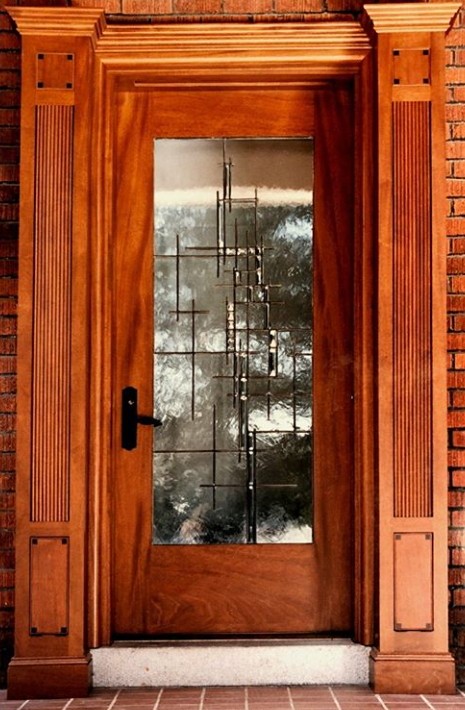
I created this window for a couple in Richmond, VA around 30 years ago.
They contacted me about a week later saying they ordered a pizza last night and when they opened the door, the pizza delivery fellow said, “Oh, you have a Wayne Cain window!” I consider this one of my greatest compliments.
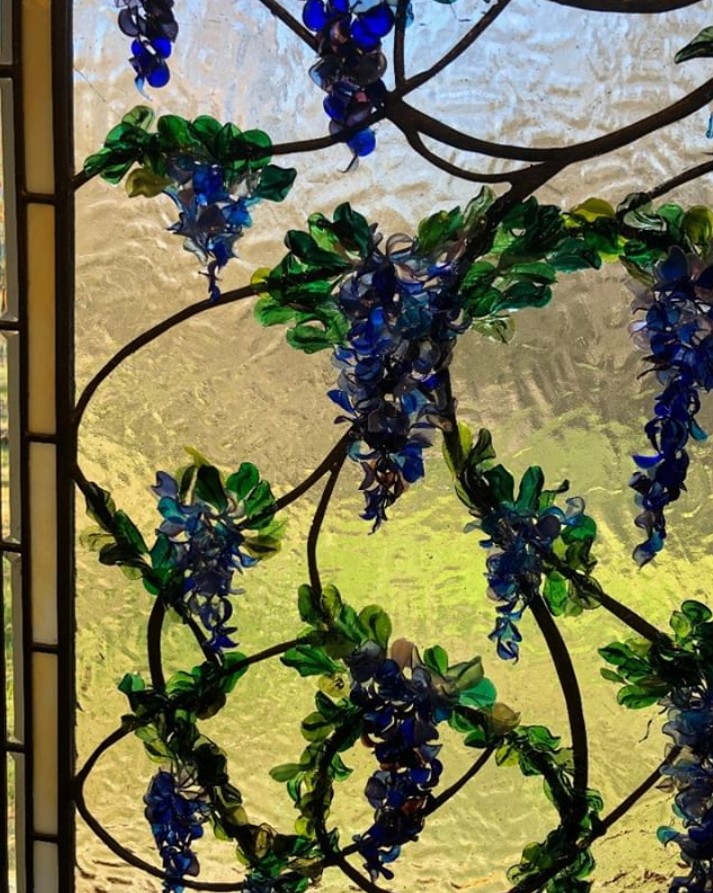
Our recently completed Wisteria window, for a home in Chicago. Each petal and leaf was created individually to create an original window, never to be reproduced.
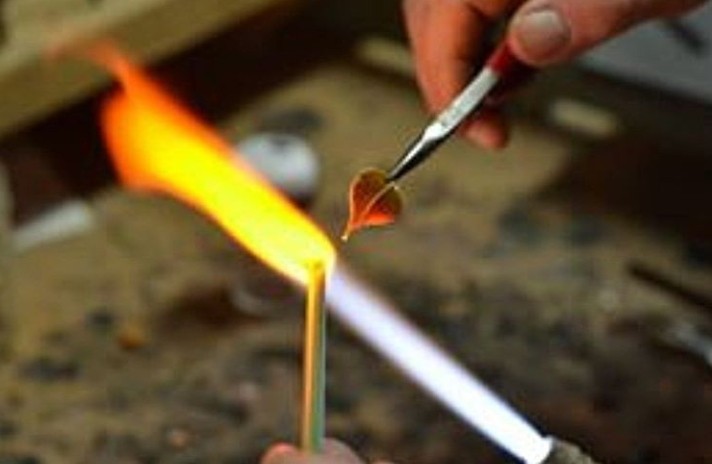
Working a strip of stained glass over a flame has advanced our goal of emulating the translucency of nature into our work.

I created this drawing 30 years ago when I was going through my rebellious period concerning symmetry. Of course, it went over like a lead balloon, so I thought I would revive it in my “mature years” to see how it’s received.

I’m always amazed by the effort that goes into our symbols. The contour of the pages, the positioning of the text, and the look of age takes considerable study. By waxing the glass to a clear background glass, we are able to study the effects of natural light before assembly. Painting by Daniel White.
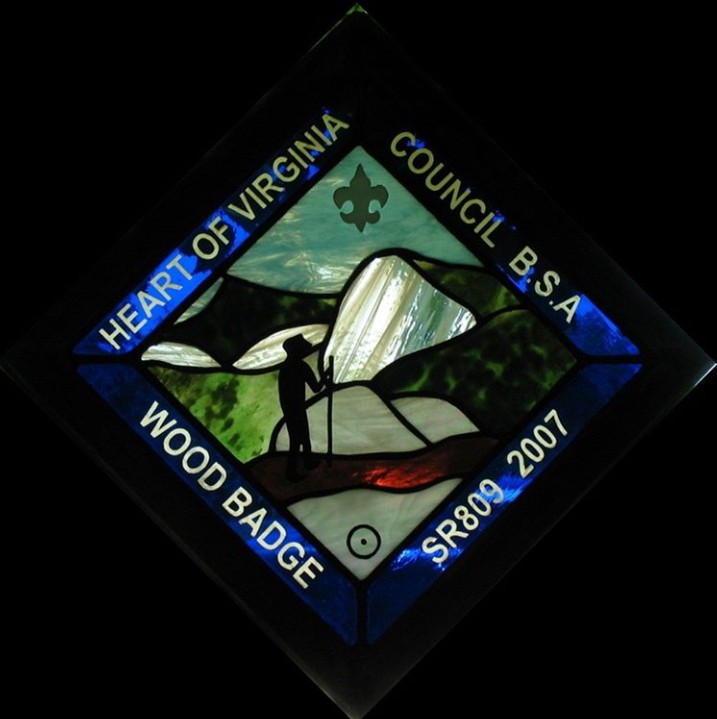
For the past 15 years or so, we have been honored to make the annual stained glass award for the T. Brady Saunders branch of the Boy Scouts of America.
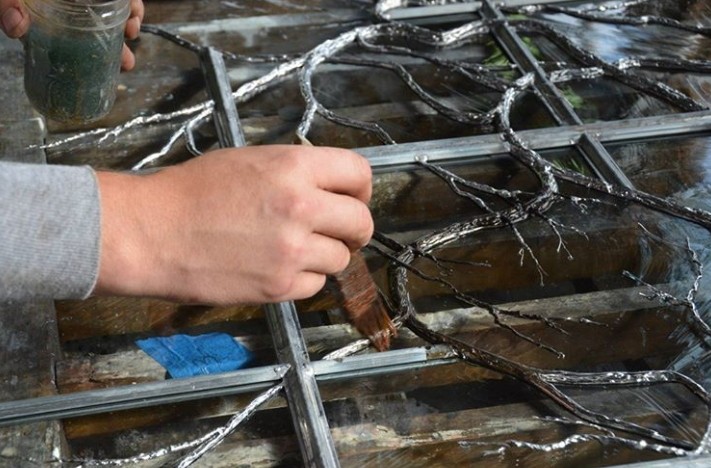
This photo requires close inspection. Here we are sculpturing tree branches on copper wire so they intertwine with the zinc structure of the window, and then applying patina for a lifelike effect.
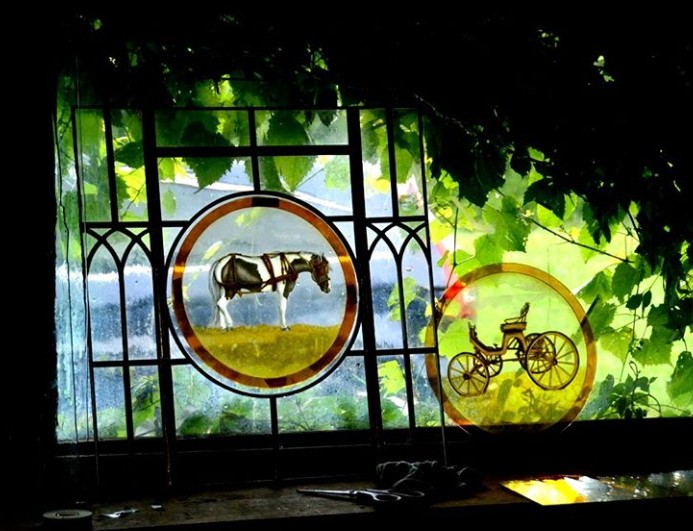
We always enjoy living with our work before installation.

We are so pleased with how our flameworking continues to improve.
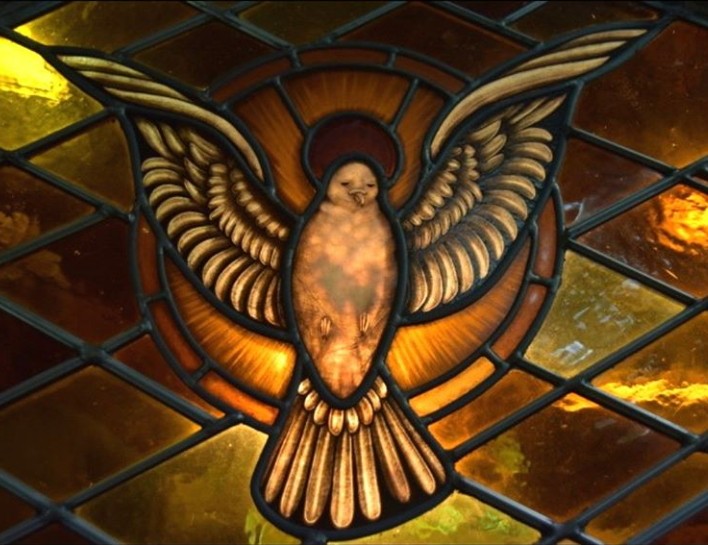
Sometimes the background and symbols just seem to work together so beautifully. Painting by Daniel White.

Look closely for the clear glass sculpture that we incorporated into this stained glass window. A nice balance of subtlety and drama with the background blown glass from Germany.
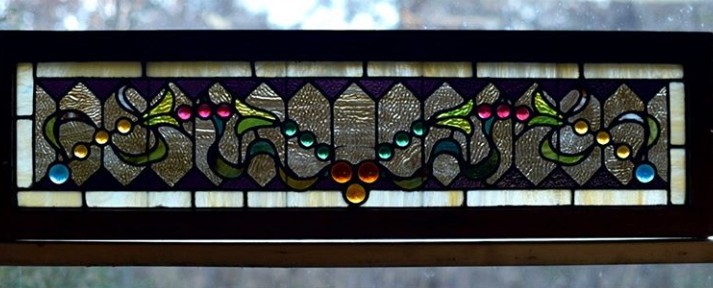
We learn so much from the restoration of historic windows. This is one of our favorites.
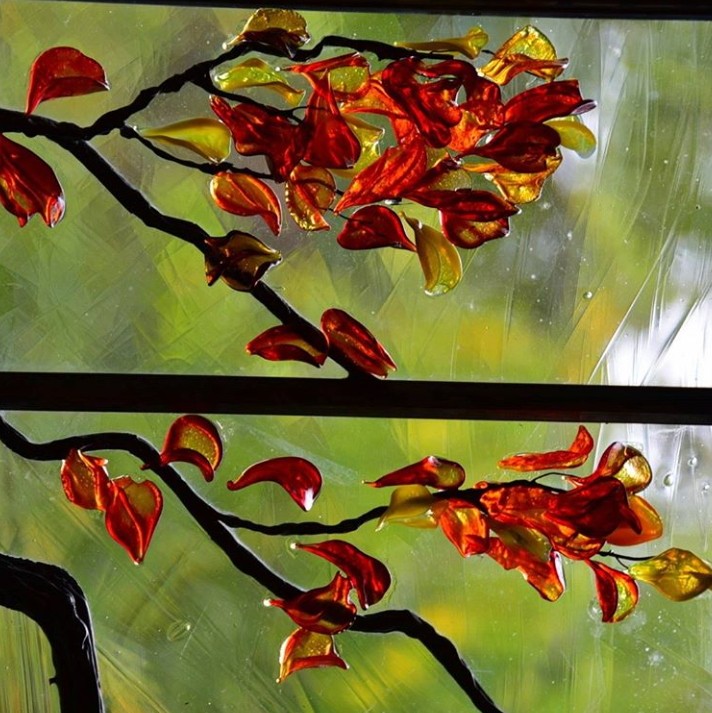
This is one of our favorite selections from our flameworking, highlighting the translucency of nature.
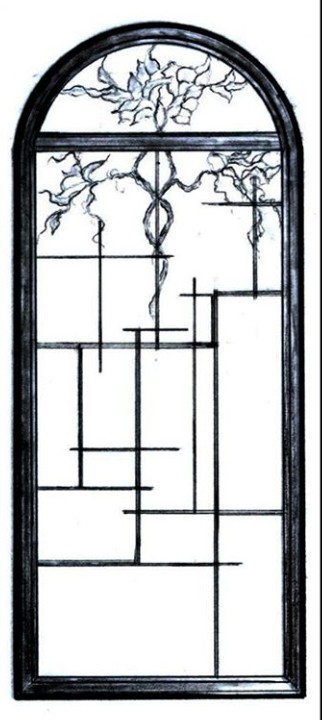
This is a design that evolved while I was playing around on the drawing table one day. My hunch is, I was influenced by the vines that grow up the VDOT signs this time of year.

By moving around the sanctuary, the lights reflecting off of the colored mirror created an interesting focal point in the sanctuary.
We worked in collaboration with the wonderful people at St. John’s Lutheran Church in Emporia, VA to create this beautiful visual addition to their church.
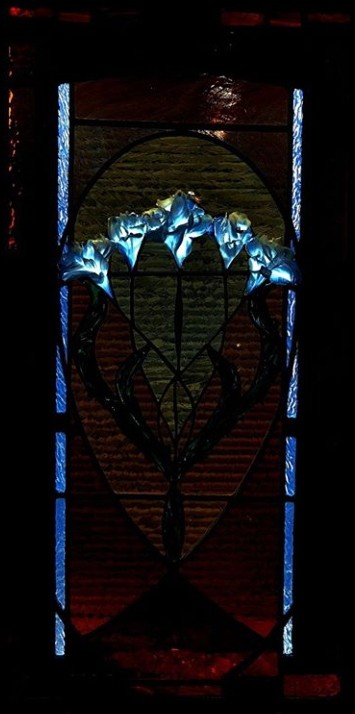
This was one of the most pleasant surprises we’ve had in a while. Our newly installed window capturing the final light of the day.
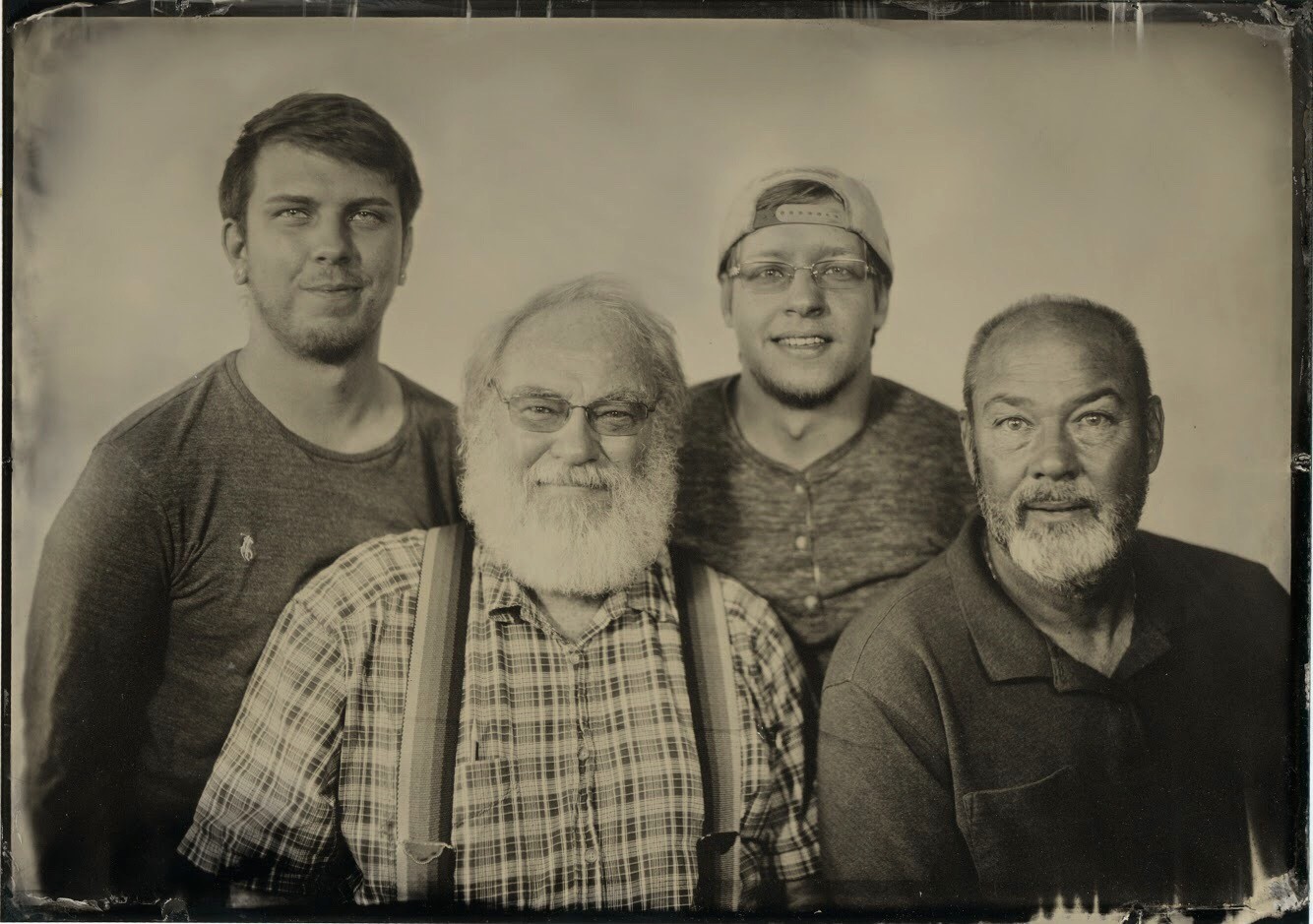
Went to Richmond yesterday and had our studio portrait made by @tintype_rva. If you ever want to be in the presence of a true artist and walk away with a piece of art, you may want to visit Emily.
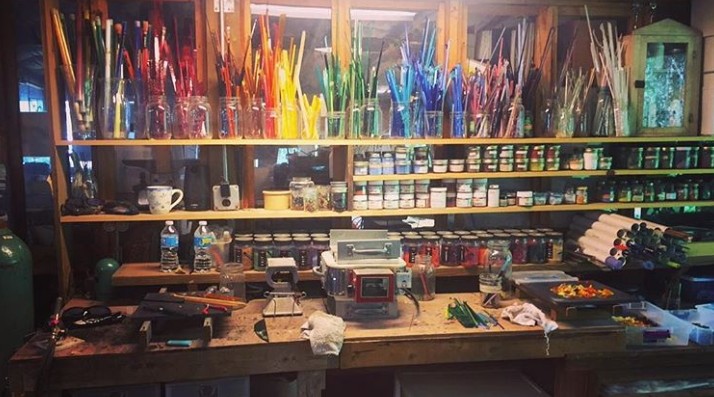
No excuses, it’s up to the artist now!
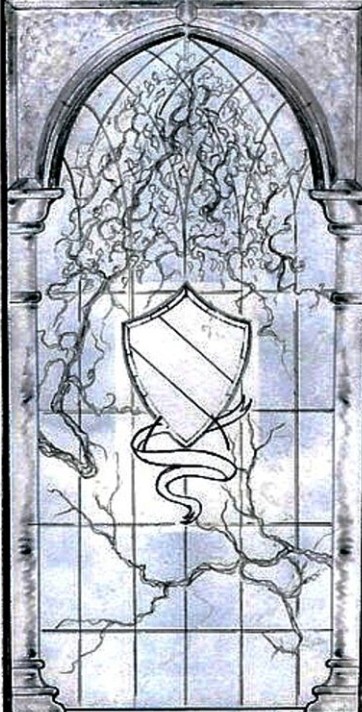
This is a design that kinda got away from me on the drawing table. It reminds me of a window from a deserted building.
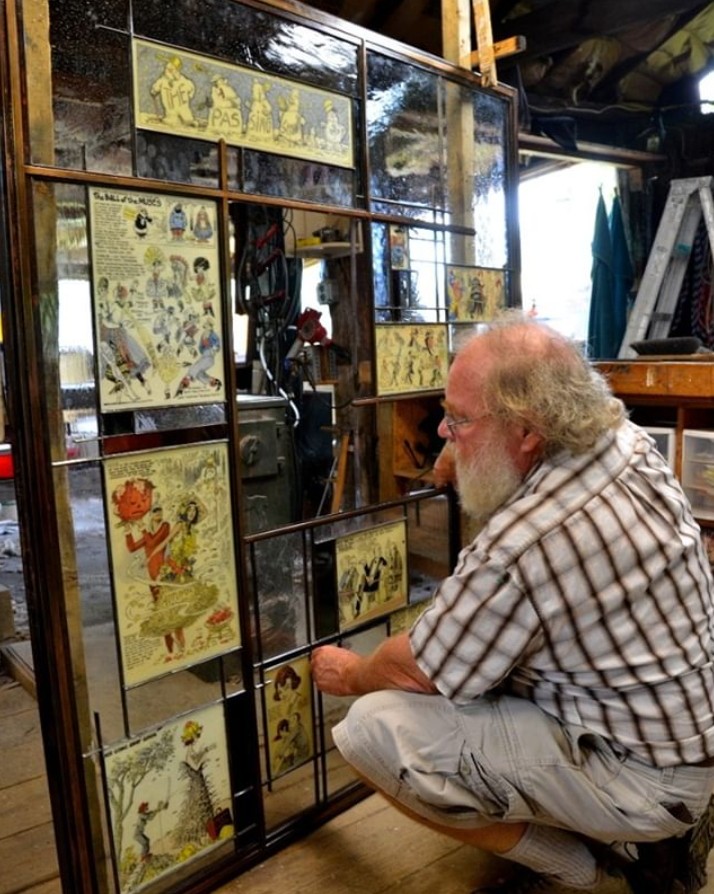
Wayne checks and re-checks details all along the way.

By using silver stain, we transformed the background glass from simple clear glass to gold. This transformed this private chapel into a warm glow. Painting by Daniel White.

My stepson, Daniel White, is the painter on all of our projects.
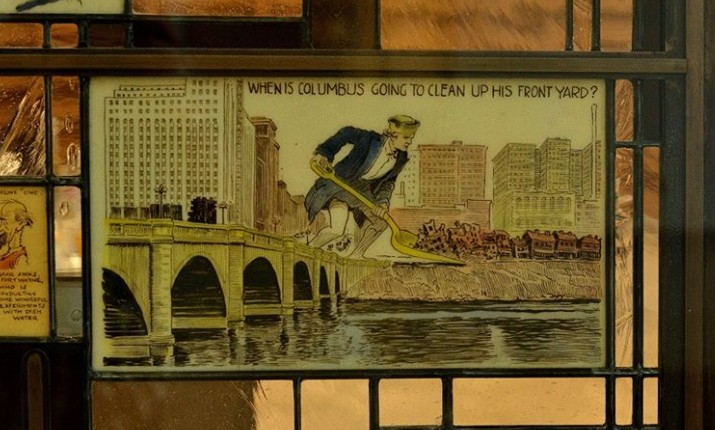
A painted section from our Bily Ireland Museum project. Painting by Daniel White.
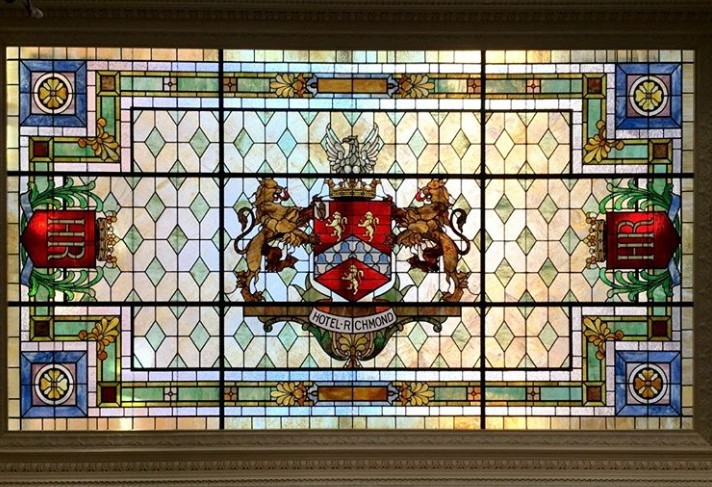
A restoration we completed several years ago at the historic Hotel Richmond. The skylights spanned over 12 feet wide and were hidden under over a hundred years of filth.
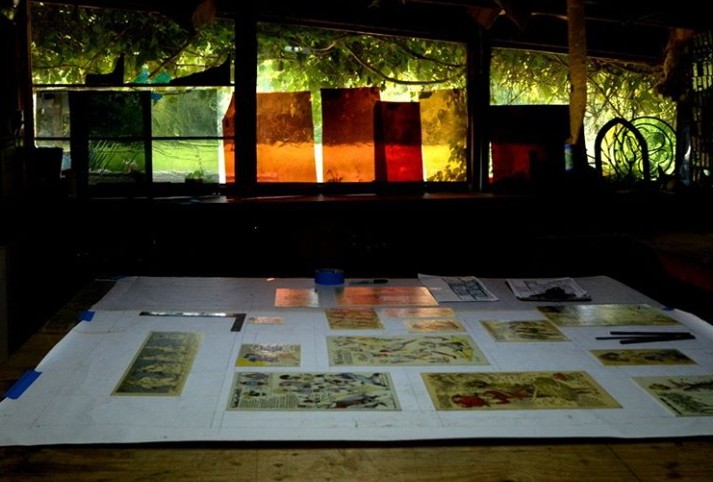
One of the best parts of our job is living with beautiful colors.
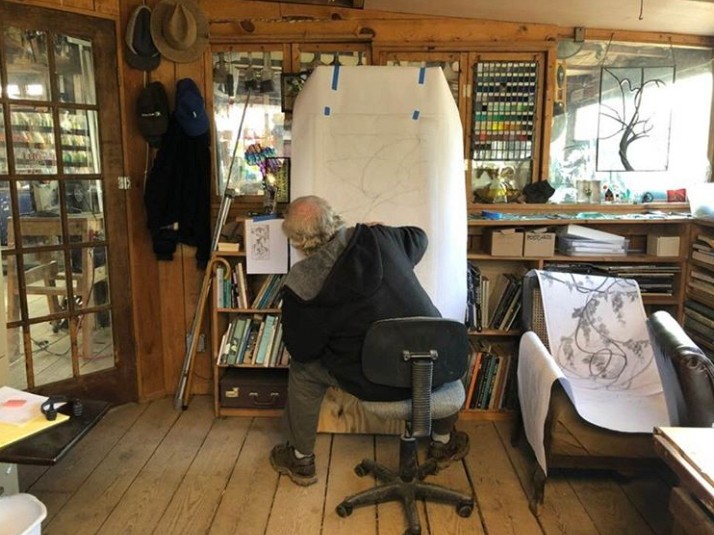
This is not Norman Rockwell.
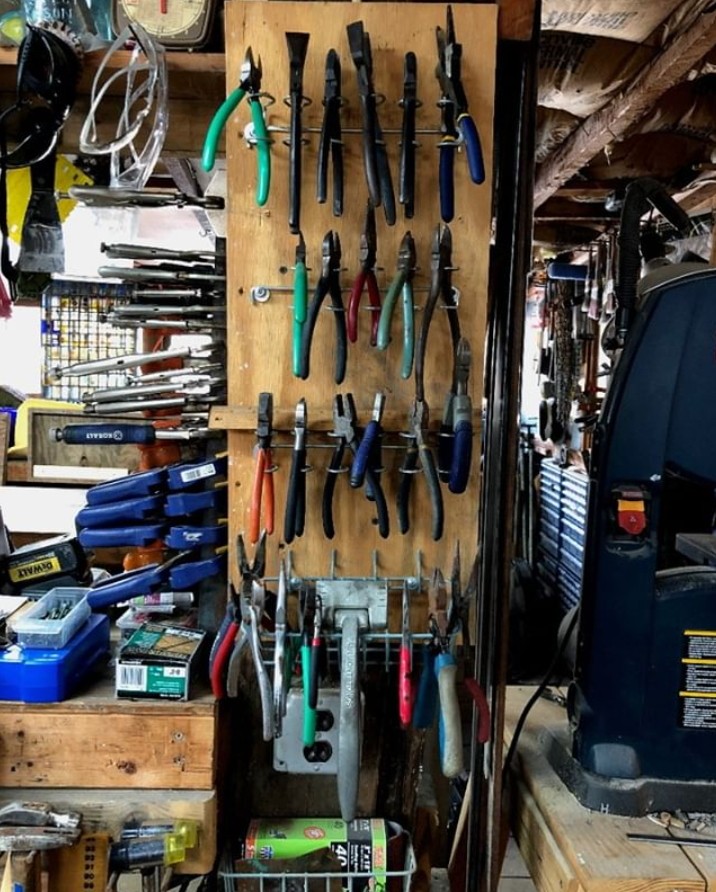
Starting a new series of projects so someone did a clean sweep of the shop and put all the tools back. When I walked by, seeing this, it startled me to the point I had to take a picture.

A window we created for St. Thomas Aquinas Chapel in Charlottesville, VA. Painting by Sean Flaherty.
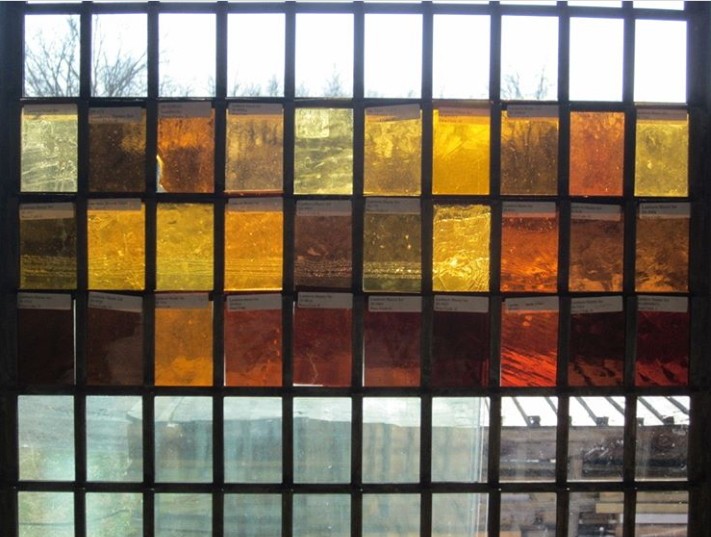
We take color selection very seriously for each project that we undertake.
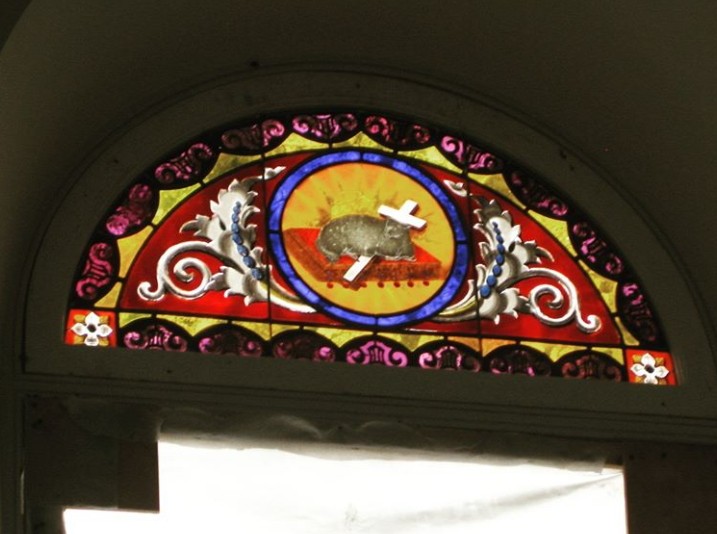
A window from one of our restoration projects. This required touch up painting that was performed by Daniel White.

The altar window at Grace and Glory Lutheran Church in Palmyra, VA.
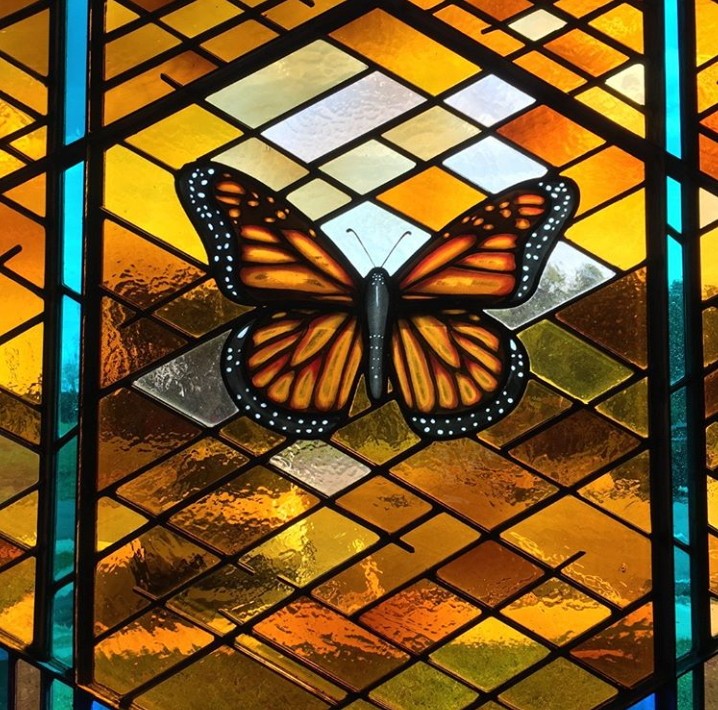
A detail from one of our windows at Grace and Glory Lutheran in Palmyra, VA. Painting by Daniel White.